Ryzen 3000 Review: AMD’s 12-core Ryzen 9 3900X conquers its past - johnsonnoteduckers
At a Glance
Pros
- Fantastic multi-core performance and comparable singular-threaded performance
- Competes with far pricier CPUs
- Native PCIe 4.0 support
Cons
- PCIe 4 lonesome when paired with newest motherboard chipset
- Motherboards slightly more expensive than before
- Slightly trails Intel in gaming operation
Best Prices Today
Update: We've since added 3D viewport and Synegy's Cinescore performance results and have updated our gambling benchmarks to include scores for the older Ryzen chip in Army for the Liberation of Rwanda Cry 5 and Deus Ex: Mankind Coalescing.
Our review of AMD's 12-core Ryzen 9 3900X CPU, in five words:
Damn, this CPU is fast.
But keep reading, because the Ryzen 9 3900X is likely as of import, and likely as game-ever-changing, atomic number 3 AMD's original K7 Athlon-series of CPUs that crossed the 1GHz occupation first, or its Athlon 64 Processor that ushered in 64-chip computing in a screen background PC.
You'd think the Ryzen 9 3900X would ingest a rough sledding achieving the same enormousness. It's true that it doesn't quite shake whol the gaming-performance bugaboos of past generations. Just we think when the dust settles, the CPU series leave easily be a first-ballot, CPU hall of fame entry.
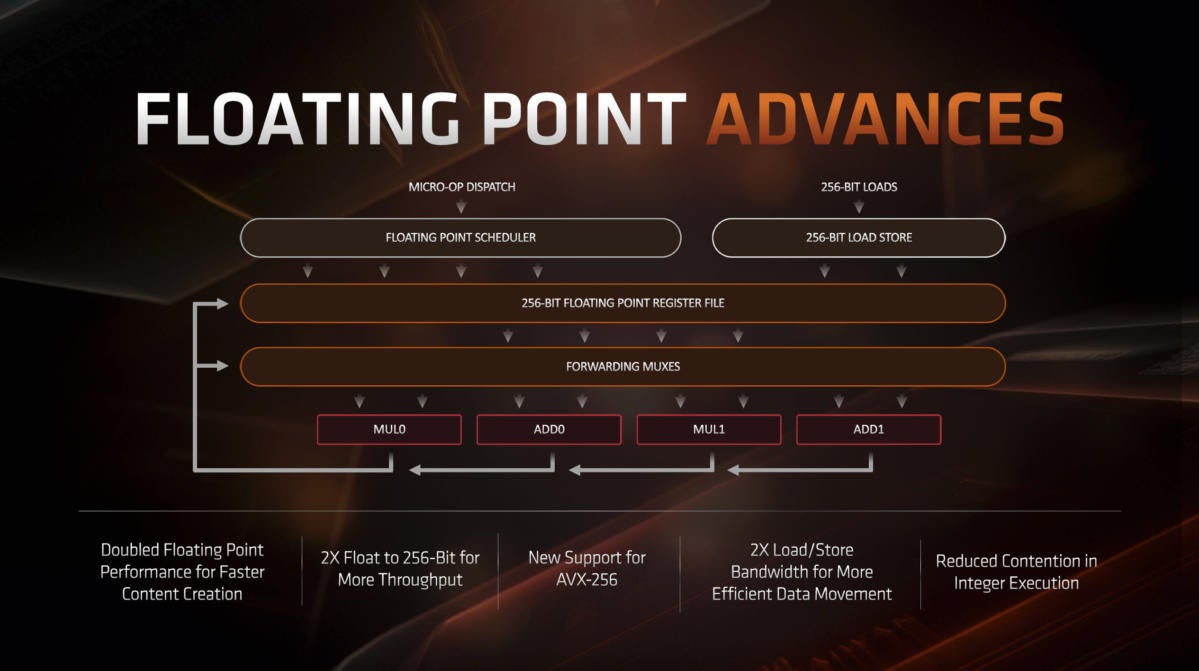 AMD
AMD AMD said IT has improved its floating point performance by 2X happening its Ryzen 3000 series of CPUs.
It is, after totally, the first consumer x86 chip to be produced happening a 7nm process node. Intel's current background chips are still all assembled on a 14nm process node, and the company bequeath just commence to move to 10nm later this year. We suspect the chip large is a bit envious that AMD reached this tiny die shrink first.
With that production technology lead, AMD breaks impermissible a redesigned 2nd generation "Elvis" marrow for the Ryzen 3000 that promises double the floating point execution finished the previous Ryzen 2000 serial, as well as a 15-percent increase in "instructions per time" (think overall efficiency per clock).
On an even deeper level, AMD said it has developed instruction pre-fetching, farther enhanced the instruction cache and doubled the micro-op cache. Besides doubling the floating point performance, AMD has now adoptive AVX-256 (256-bit Advanced Vector Extensions) (and yes, Intel fans, we know Substance has AVX-512). AVX's bear on is by and large seen in video encoding nowadays, but it can rear its performance head elsewhere also.
AMD has essentially doubled the L3 cache on the Ryzen 3000 chips, and the companion is going for some Apple-esque selling by calling it Mettlesome Hoard. The cache, up to 70MB happening the Ryzen 9 3900X, goes a long way toward reduction memory latency on the Ryzen 3000s. It too tends to hike up gaming performance dramatically on the CPU, so AMD feels calling it Gritty Cache can help the average consumer understand its benefits. Yes, that larger L3—err, Game Cache will also help application performance, but no one gets excited about App Cache we opine.
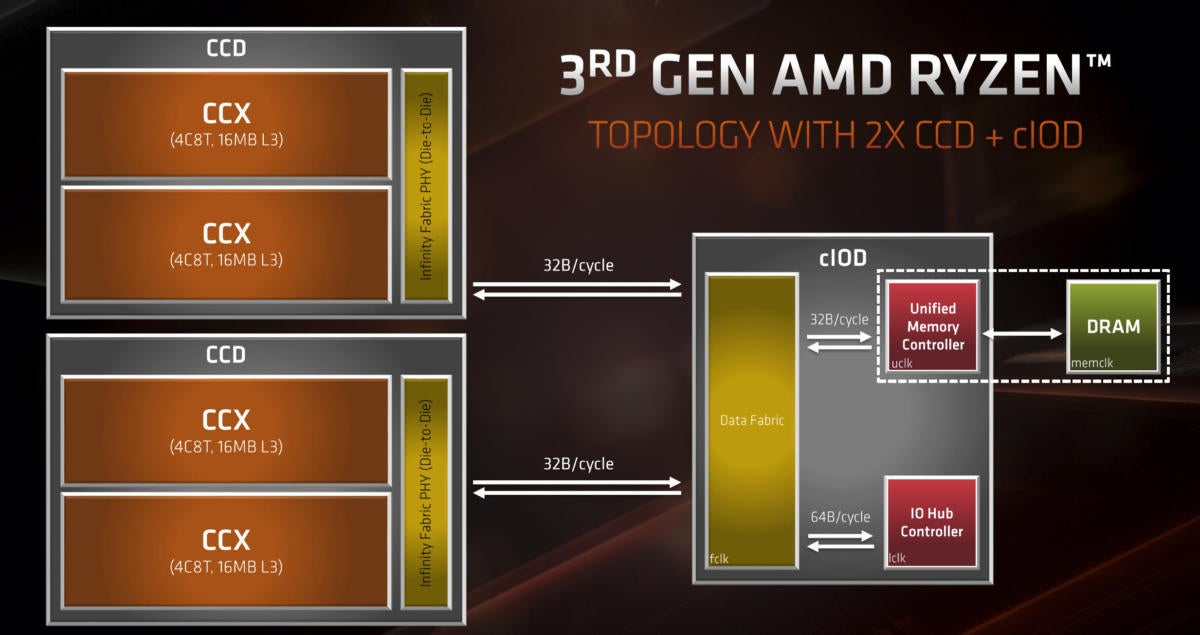 AMD
AMD The Ryzen 3000 features two 7nm CCDs, which feed into an IO die that has the storage controller and PCIe controller.
Besides the cores, AMD has likewise importantly rejiggered its chiplet design. Patc the master Window pane-based Ryzens conspicuous two 14nm CCDs along with their retention and PCIe controller connected with Eternity Fabric, the Zen 2-based Ryzen 3000s actually removed the memory controller and PCIe 4.0 controller on dissever IO dies. Unlike the 7nm compute cores, the IO die is built on a 12nm operation. This helps lower the overall cost of the Central processing unit because it saves AMD's fab partner, TSMC, from using even more valuable 7nm process wafers to build the IO dies.
The thousand-clam motion is whether gambling—which has unregenerate Ryzen functioning from Day One—has finally been erased in situations where the GPU is not the limiting factor. We can allege from what we've seen that Ryzen 3000 doesn't quite win complete of the clip, but it's so close now, even with Nvidia's brutally fast RTX 2080 Ti driving it, that information technology just won't matter 99 percent of the time.
PCIe 4.0?!
Yes, we said PCIe 4.0, which is the next iteration of PCIe. PCIe 4.0 essentially doubles the clock speed and throughput all over PCIe 3.0. AMD's locomote to PCIe 4.0 is another feather in its capital, as Intel continues to cohere with PCIe 3.0 speeds happening its CPUs. Nvidia, likewise, "only" has PCIe 3.0-based GPUs.
While the actual performance of PCIe 4.0 outside of SSDs today North Korean won't be easy realized, the new definitive does help free up more lanes and more ports elsewhere in the PC. If you wish to capitalize of PCIe 4.0 SSDs, AMD's Ryzen 3000 and the new X570 chipset is the only game in town.
You can read all about PCIe 4.0 in this explainer. If you're confused nearly the simultaneous presence of PCIe 5.0 and PCIe 6.0 in earlier stages of development, remember that it takes metre to go from initial spec to actual hardware. PCIe 4.0 is basically the single answer now and a decent bragging point for AMD.
Boatloads of value
And yes, there's quieten value. Patc Intel charges $488 for its flagship 8-core Meat i9-9900K, AMD leave give you 12 cores it claims are fair-and-square as fast, if not faster, for $499, with a bundled RGB cooler too.
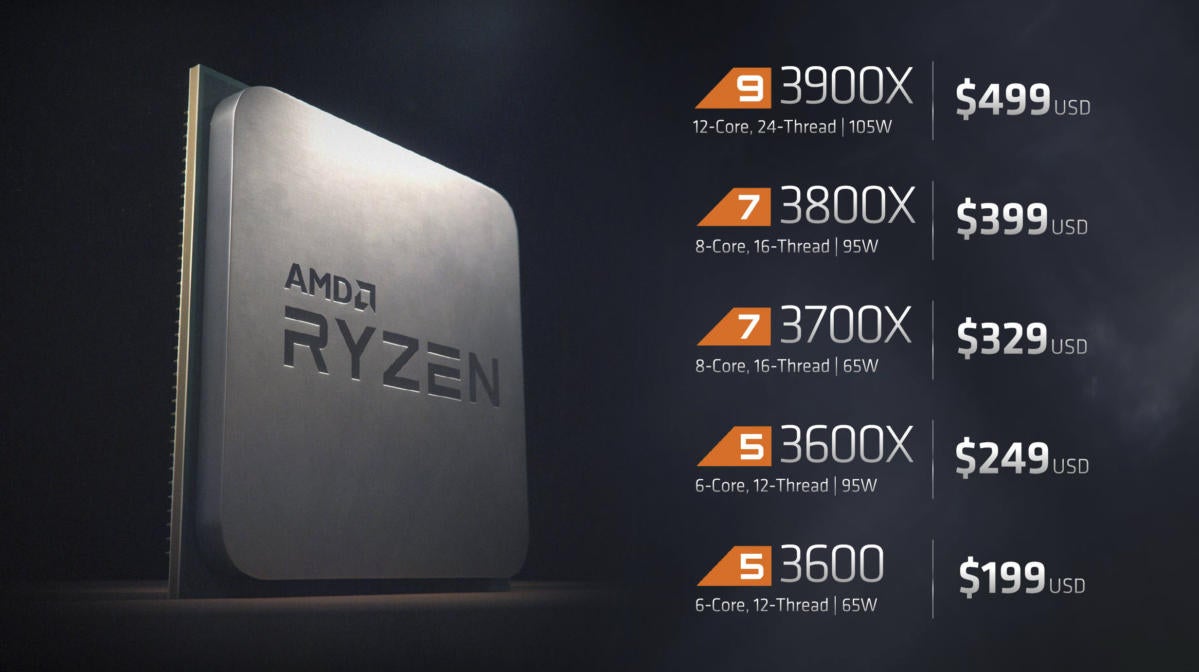 AMD
AMD AMD's batting order of Ryzen 3000 seems poised to push Intel's entire lineup off the theater of operations of struggle.
How much prize? To watch just how much buck per yarn you're getting, we mapped taboo the CPUs supported how much you for each one thread costs. As you can see, AMD owns Intel in this family. At $21 per thread for the Ryzen 9 3900X, the $31 for the Core i9-9900K isn't even in the same approximate range.
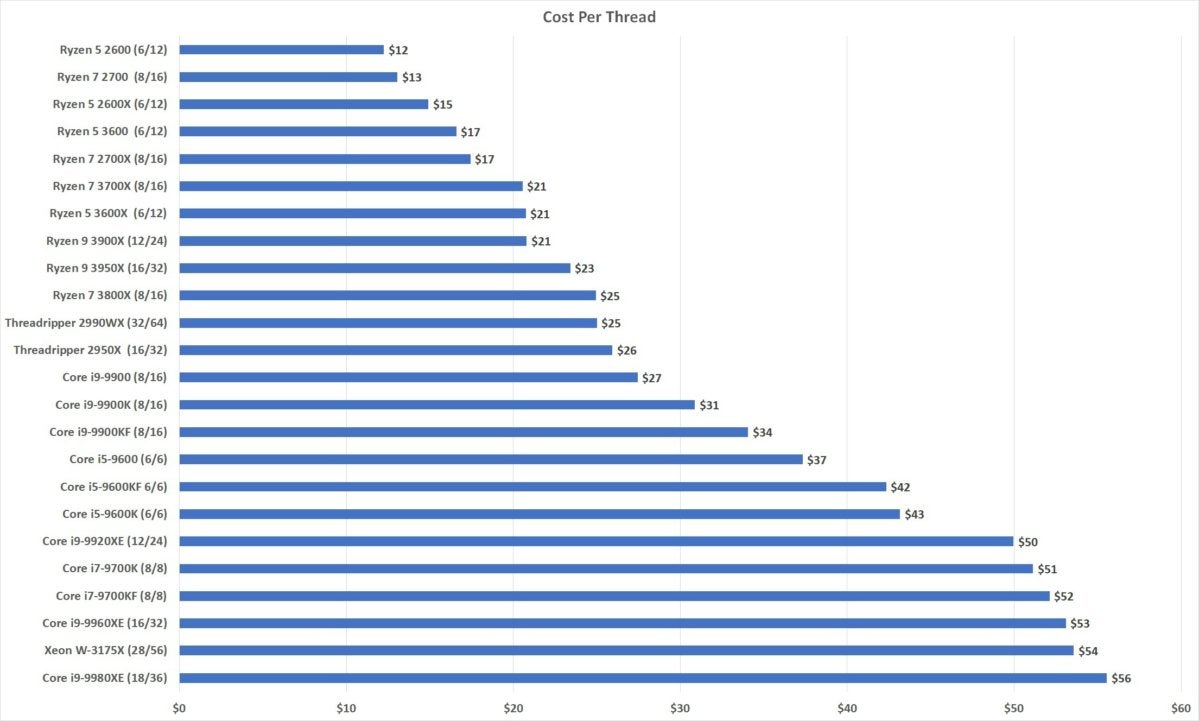 IDG
IDG None of the cost-per-thread or fancy 7nm process matters, though, if the performance isn't on that point. Let's get on with what you came hither for: to find out how secured the Ryzen 9 3900X is.
How we time-tested
For this review we decided to focus in on three key CPUs. First we use AMD's 2nd-coevals Ryzen 7 2700X as a service line. Second we bring in general contender at $488: Intel's mighty Core i9-9900K. The last chip is none some other than AMD's $499 Ryzen 9 3900X.
We tested each CPU in parallel, with the Ryzen 7 2700X mounted in an MSI X470 Gambling M7 AC, the Nucleus i9-9900K into an Asus Maximus XI Hero, and the Ryzen 9 3900X into an MSI X570 Superhuman.
For graphics, the first Central processing unit and whatsoever biz testing were performed with Founders Edition GeForce GTX 1080 card game. We ran additional game testing with Founders Edition GeForce RTX 2080 Ti cards.
All three builds used the latest obtainable UEFI/BIOS and drivers and fresh installs of Windows 10 Professional 1903. This reading of Windows is peculiarly important, because AMD says 1903 now includes scheduler optimizations that help it dispatch duds in more efficient manner on Ryzen 3000.
Remember: AMD's CPUs are constructed with small cities of CPU cores and high-cannonball along, only slower access betwixt the cities of CPU cores. In older versions of Windows, the scheduler would dispatch one thread to a urban center in one bunch. Because information technology was never designed for multi-die designs, IT would beam a second thread to a contrary flock of CPU cores. This would fool some performance, as the threads would then have to deal with crossing between the two clusters of cores instead of simply dispatching both threads to the same cluster of CPU cores. That's now fixed, and Windows 1903 bequeath send duds the equal cluster of CPU cores when possible. This, AMD claims, can yield high to a 15-percent boost. Officials also say it's not homogeneous in every applications, however, so your gasoline mileage will vary.
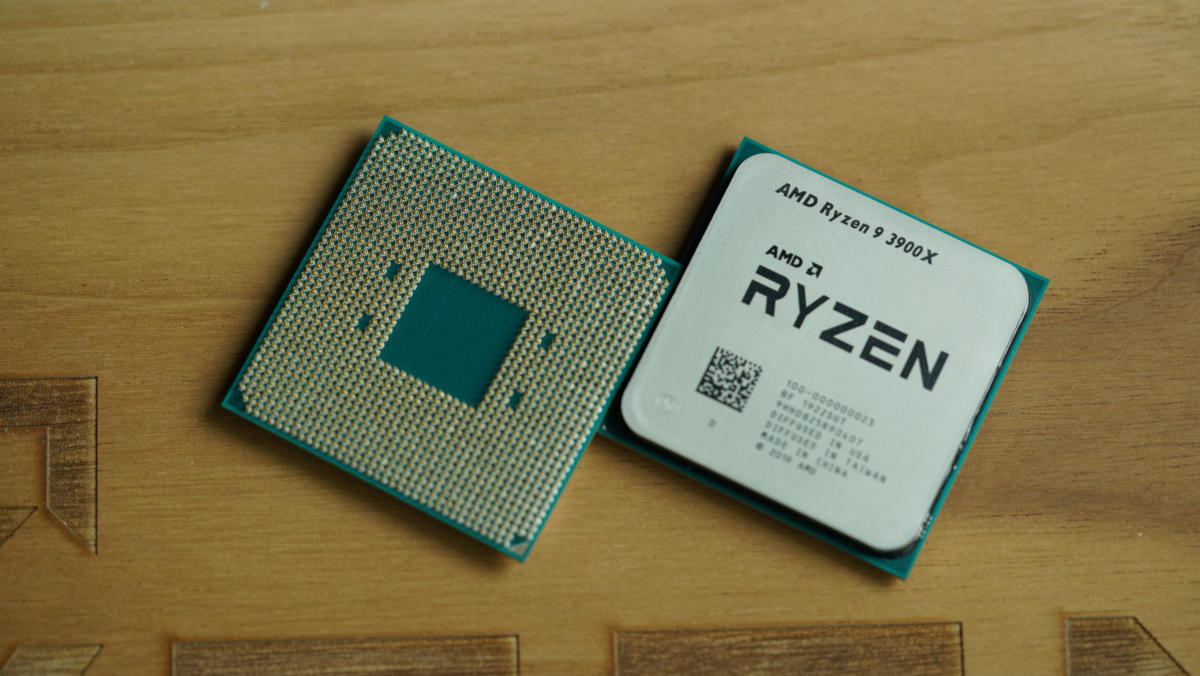 Gordon Mah Ung
Gordon Mah Ung AMD's new 12-core Ryzen 9 3900X is the new leader among mainstream performance CPUs.
While we old the like amount of DDR4 in threefold-channel modes in altogether three builds, we did vary 1 aspect by running the Core i9-9900K and Ryzen 7 2700X with 16GB of DDR4/3200 CL14, and the Ryzen 9 3900X with 16GB of DDR4/3600 CL15. We precious to test the Ryzen 9 with its optimal memory clock, which is 3,600MHz. We intend to test it at 3,200MHz as well. Attributable fourth dimension constraints, we're initially showing only DDR4/3600 performance and will update it with DDR4/3200 erst time permits. We are told by AMD, however, that DDR4/3200 CL14 should yield roughly single-digit operation differences compared to DDR4/3600 CL15.
The other variable here is storage. For the Ryzen 7 and Core i9, both were dependable with very riotous MLC-based Samsung 960 In favor 512GB SSDs at PCIe 3 Gen 3 speeds. The Ryzen 9 3900X, however, is the first C.P.U. and platform we've seen to support PCIe 4.0. Because information technology is a key feature of the new platform, we old a 2TB Corsair MP600 PCIe 4.0 SSD obstructed straight into the CPU's PCIe lanes. For the tests we're running, storage should not impact Central processing unit performance.
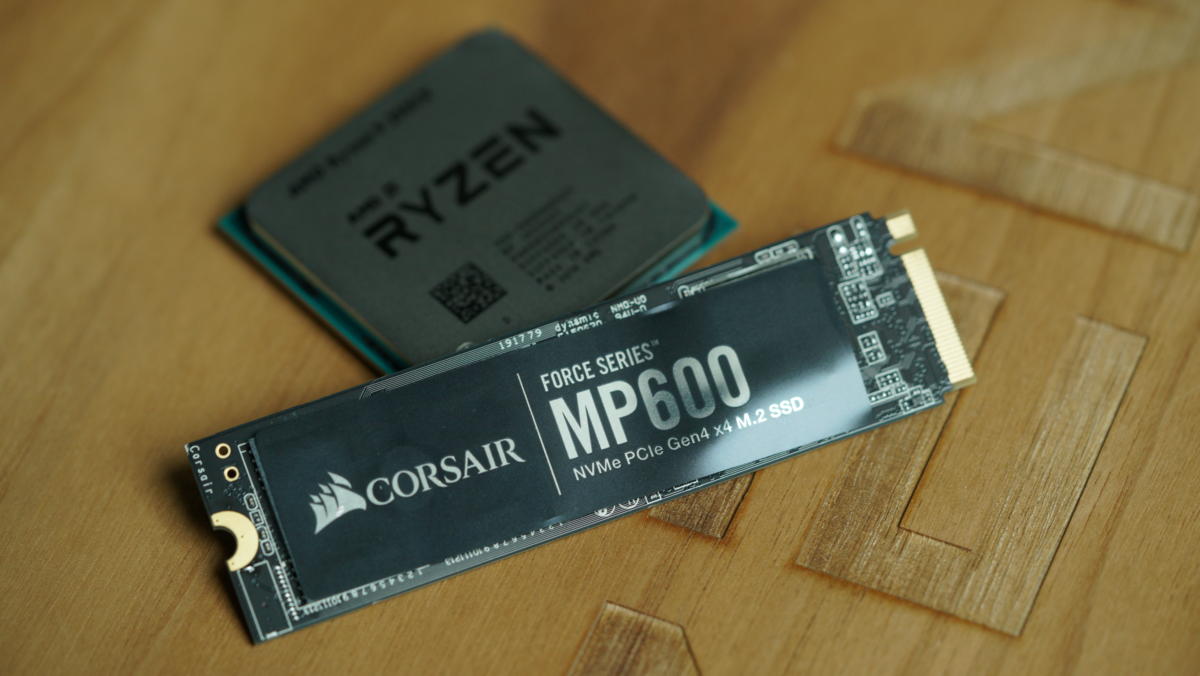 Gordon Mah Ung
Gordon Mah Ung Corsair's MP600 supports PCIe 4 happening AMD's new Ryzen 3000 CPUs.
To MCE or not?
For this review, as with our underived Core i9-9900K review, we were mangled as to whether to enable the "multi-core enhancement" feature. MCE is a motherboard-enabled feature that runs Intel "K" CPUs at higher time speeds, while using more power and producing more heat. What offends some is that MCE is technically a violation of the alphabetic character of Intel's law and considered an "overclock."
You'd mean that makes turning it disconnected an gradual decision. The problem is, honorable about all middle- to high-end Intel motherboard implements MCE put off to auto out of the box. That means that any reviews of these new CPUs with the feature explicitly set to off, is not quite an honest portrayal of the true nature of the Core i9-9900K's hotfoot that about consumers will experience.
Leaving it on gets even stickier, because every motherboard maker implements information technology slightly differently. There's no easy way to draw an exact bead on carrying out with MCE connected.
In the stop, our tests are all run with MCE off on the Intel Processor, and AMD's somewhat similar Precision Boost Overuse upturned off likewise. We'll research this in greater depth in other story, but for now note that running with MCE cancelled tends to wounded Intel CPUs Sir Thomas More than running with PBO off on AMD CPUs.
Got all that? Then keep recital to see charts, charts, and more performance charts.
Ryzen 9 3900X 3D Modeling Functioning
Aweigh first is the old understudy of Maxon's Cinebench R15. This bench mark is built along the Sami engine utilized in Maxon's Movie theatre 4D modeling and animation application. Cinema 4D is also built into Adobe brick's Premiere and After Effects applications.
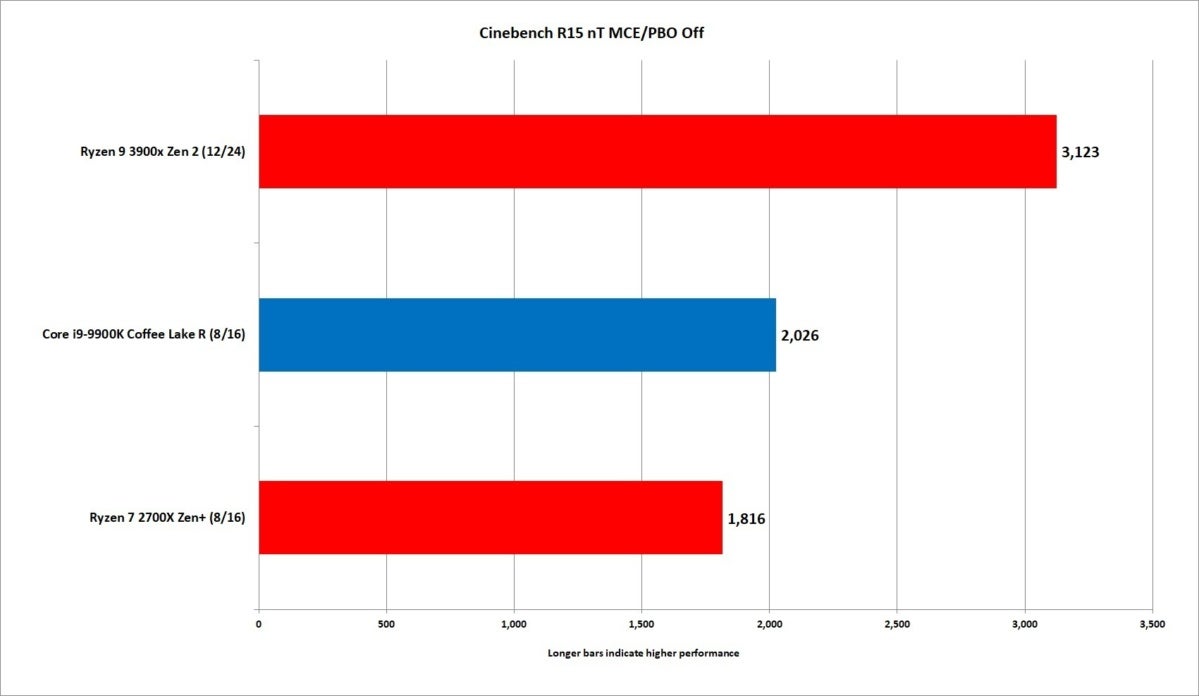 IDG
IDG No storm: 12 cores easily outguns 8 cores, making the Ryzen 9 3900X the simplified winner Here.
In the zero-surprise family, we see the 12-center Ryzen 9 3900X simply demolish the 8-core Core i9-9900K to the tune of 42 percent. With 40 percent more threads at its disposal, we sort of expectable this. Still, this is impressive performance and to follow lauded.
Perhaps more than evidential is the man-to-man-rib performance of the Ryzen 9 3900X. With a boost clock of 4.6GHz on the Ryzen 9 3900X vs. the rise clock of 5GHz on the Core i9-9900K that gives the Intel part close to an 8 percent clock advantage in pure clock speed.
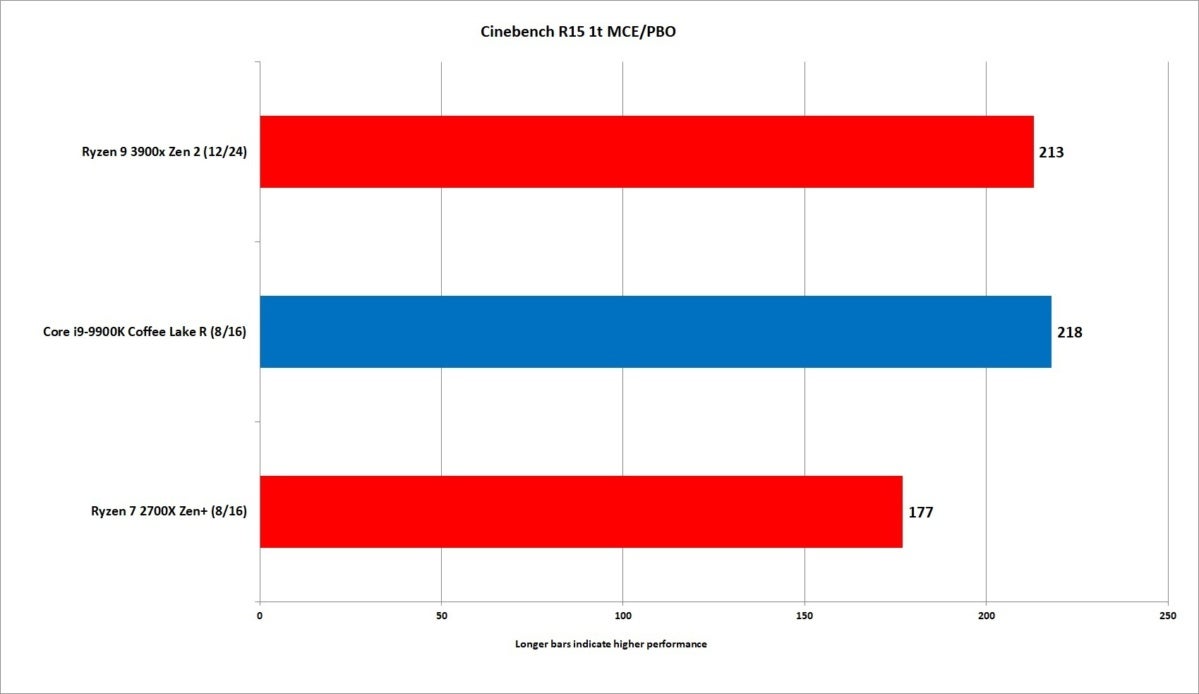 IDG
IDG That's impressive single-threaded performance for the Ryzen 9 3900X.
Non whol megacycle per second are the same, though. With AMD's very much-improved instructions per clock—essentially how timesaving the chip is—the Ryzen 9 is but 2 to 3 percent slower than the Core i9.
Cinebench R15, however, is fairly old, having come out in 2013, so we too measured all trine CPUs using the new Cinebench R20. Intel generally is a trifle faster in this updated test—against old Ze+ cores.
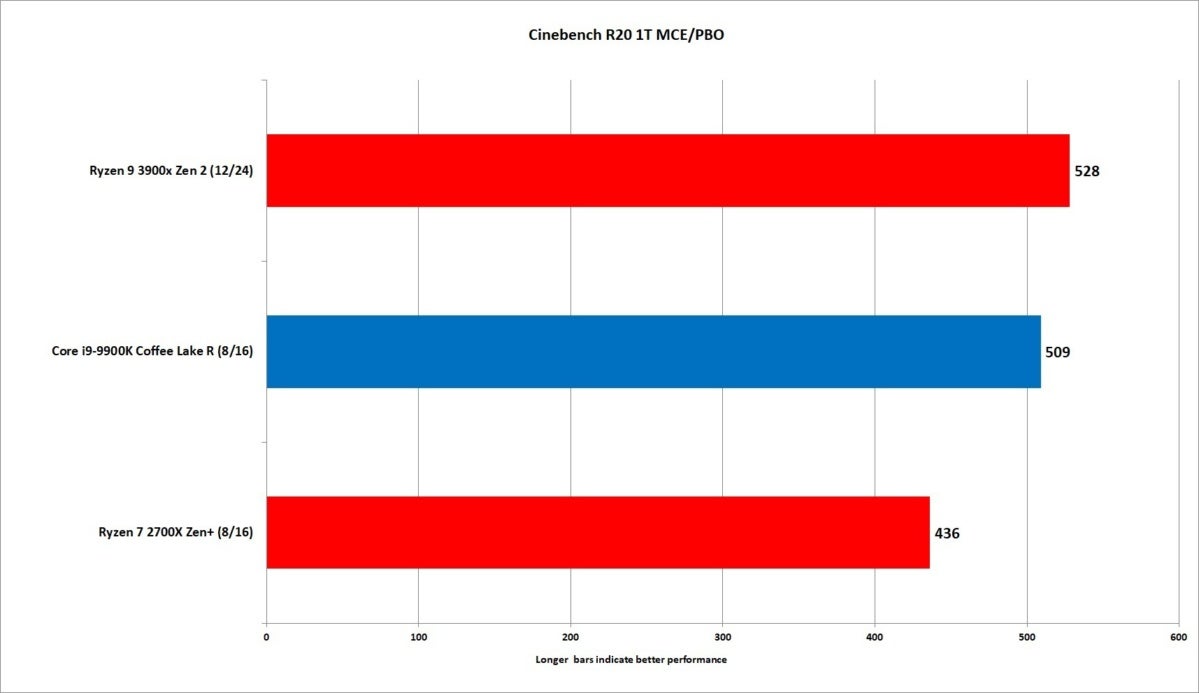 IDG
IDG Loose to the updated Cinebench R20, the Ryzen 9 3900X actually pulls ahead in single-threaded public presentation.
The situation changes for the Zen 2 cores in the Ryzen 9 3900X, subsequent in a 3-percent relegate in single-threaded performance. That's a polite shift for AMD.
The tables twist for multi-threaded performance. The 12-core AMD part smashes the 8-essence Intel part by 42 percent.
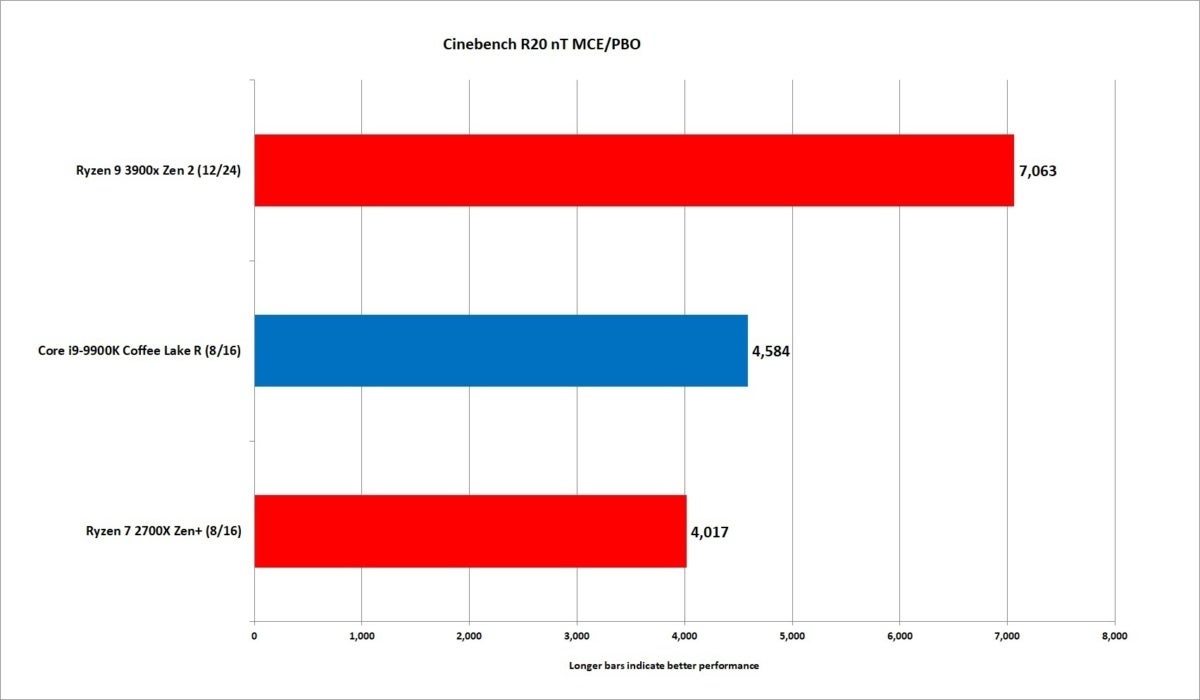 IDG
IDG No surprise: The Ryzen 9 3900X essential runs the Core i9 off the field in multi-rib performance.
We besides tested the chips using Topsy-turvyness Group's Saint Ulmo's fire Renderer bench mark. Saint Elmo's fire is a "modern indifferent photorealistic renderer," which refers to the precision in which information technology renders the picture—not unbiased based on the hardware it's keep going.
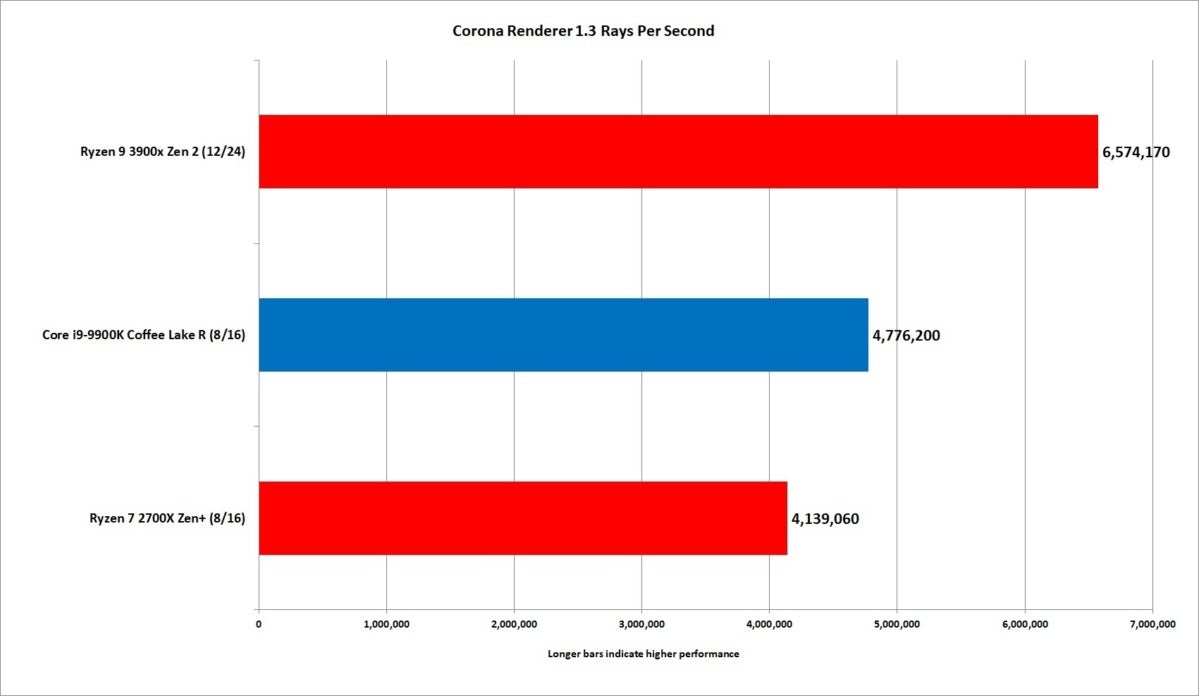 IDG
IDG The Corona modeller likes 12 cores to a higher degree 8 cores.
In this multi-threaded test, we see the Ryzen 9 outrun the Sum i9 by about 32 percent. And yup, the personify blows keep upcoming.
We run V-Ray Succeeding, which is another renderer from the Chaos Group. The result? Near 31 percent in favor of the Ryzen 9 over the Core i9.
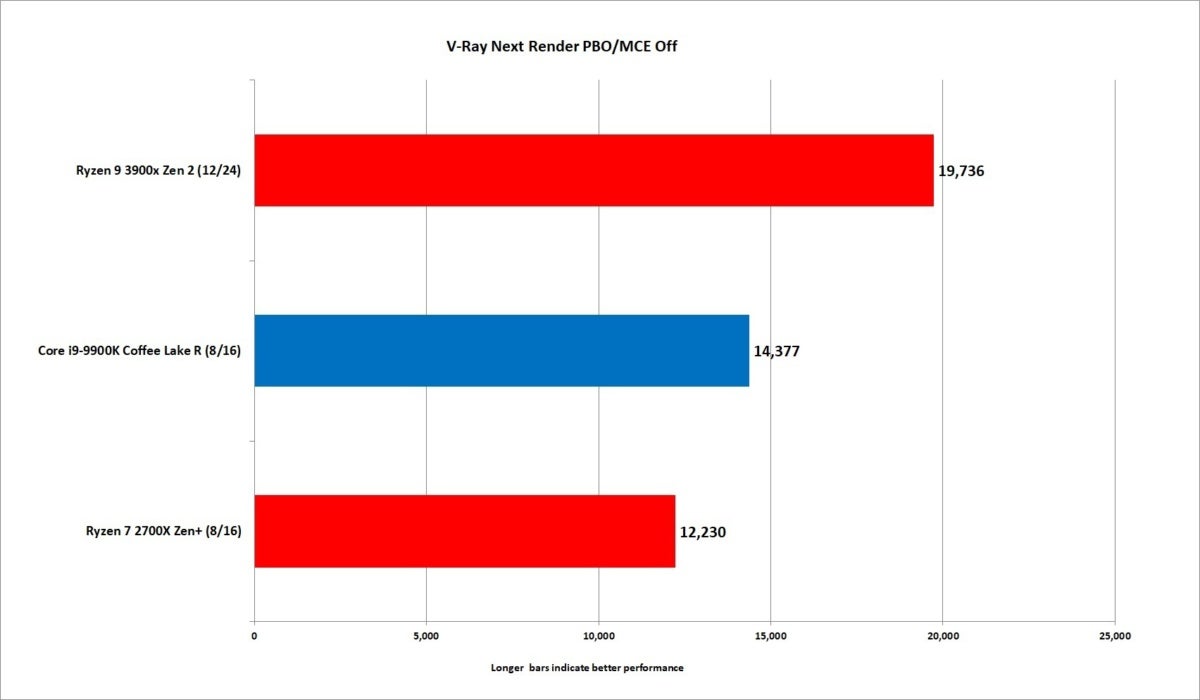 IDG
IDG Blase yet? V-Electron beam Next reinforces what we're seeing in different modelling apps.
What most the on the loose and popular 3D modeler Liquidiser 2.80, using the intensive Gooseberry bush test file? How near 43 percent in favour of the Ryzen 9 finished the Core i9.
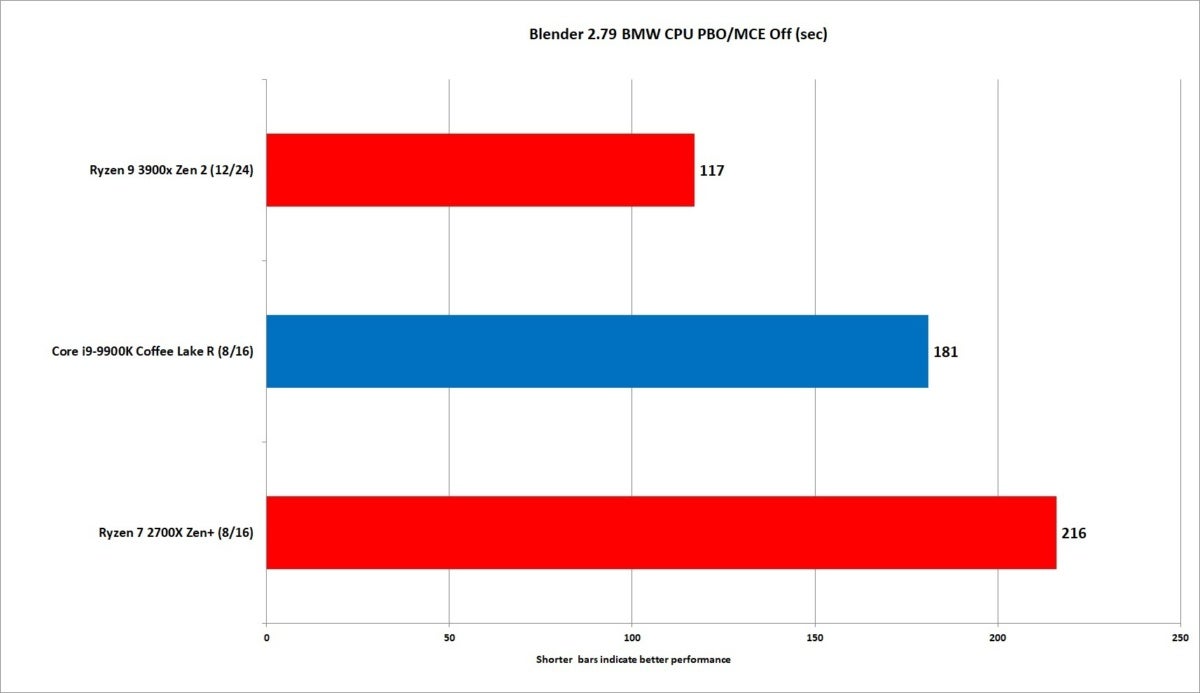 IDG
IDG Dayum. The Ryzen 9 3900X is fast.
We'll close off the 3D tasks with the golden oldie, but goodie POV-Ray 3.7 benchmark. The Persistence of Imagination Raytracer is an open-source, unhampered instrument that has roots in the Amiga platform. Using the application's built-in test, we proverb the Ryzen 9 about 44 pct quicker than the Core i9 in multi-threaded mode.
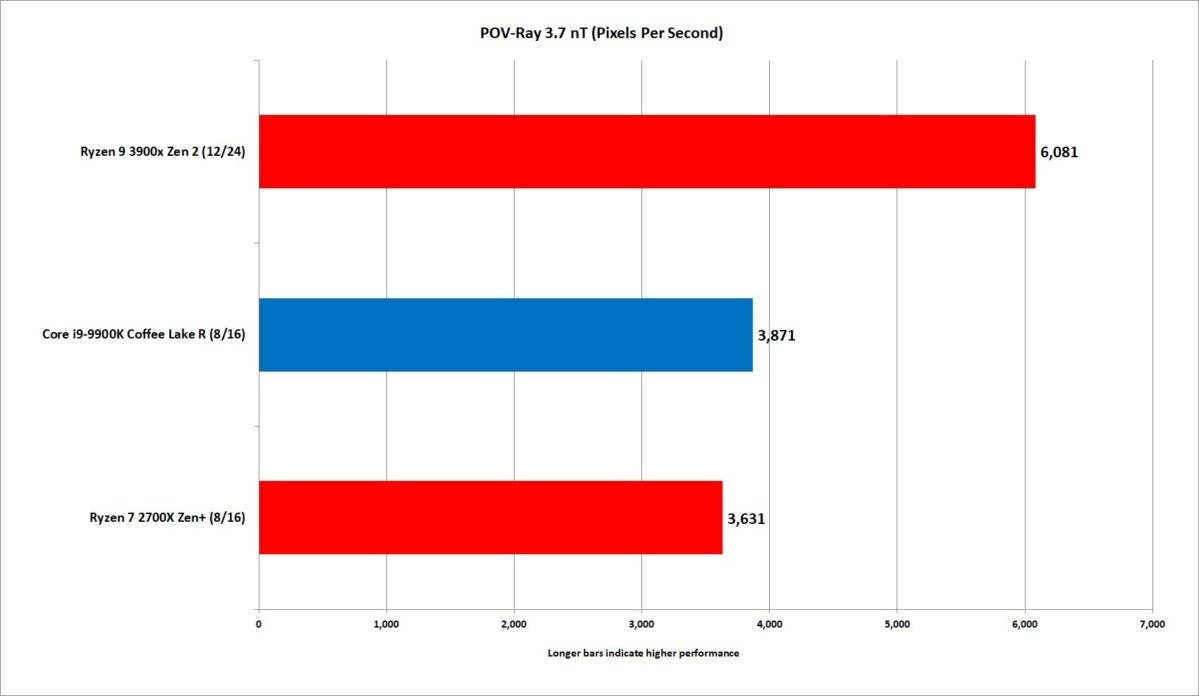 IDG
IDG What a shocker: The Ryzen 9 mops the floor with the Core i9.
POV-Ray also has a single-threaded benchmark, in which the Core i9 and its 5GHz clock ekes out a 4-pct win over the 4.6GHz Ryzen 9. A win is a win, simply most are likely to say fully grown whoop.
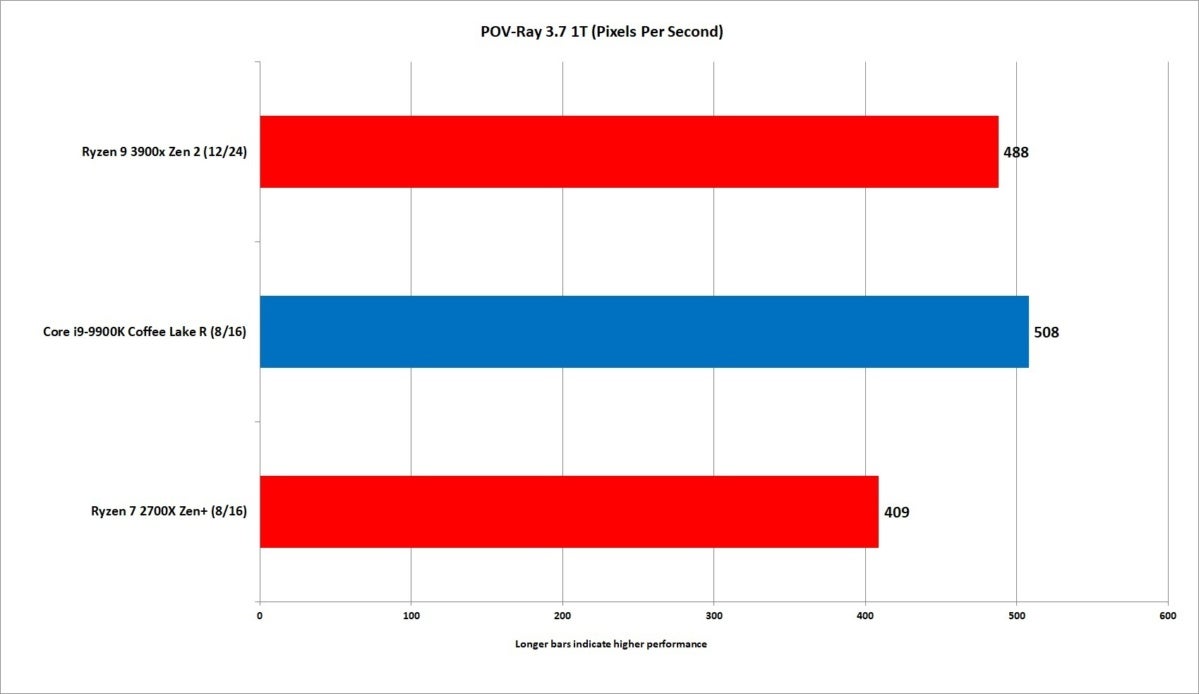 IDG
IDG The 5GHz boost clock of the Core i9 gives it a very slight edge over the Ryzen 9 in POV-Irradiatio when set to test a single thread.
Viewport Performance
Before we jump to the next section we did want to research a protest we had heard from Intel fans. We'll summarize it as, "we know the simple maths of 12 > 8 is true, only for 3D artists, the time waiting for rendering is not arsenic critical as the seat time when you actively need faster responsiveness." That is, system "snappiness" when stressful to do on the nose moulding is just atomic number 3 important if non more main. In that world, the maths of 5GHz > 4.6GHz, and so Intel wins in that department.
To test that hypothesis we looked to CGDirector.com's relieve Cinema4D Viewport Performance benchmark. CGDirector is an PC enthusiast place for 3D depicted object creators, video editors, and other users WHO run in graphics-intense applications.
For a better interface or "viewport" experience for 3D artists, CGDirector said the CPU is the chief bottleneck—and not the GPU. That means chips with higher oftenness and higher IPC typically are more essential.
"In this Cinema 4D Viewport Benchmark, we mensuration the FPS of a typic Scene that uses common 3D Objects from Movie theater 4D Objects in a hierarchy," the website aforementioned.
For this test, we ran the Cinema 4D Viewport bench mark with a demonstrate version of Cinema 4D R20.
Some of the results the site has posted register a 7th-gen Kaby Lake Nitty-gritty i7-7700K with a cost increase clock of 4.5GHz at 1,049, and a 16-heart Skylake X Core i9-9960X with a boost time of 4.4GHz at 1,045. A Xeon X5450 with a relatively low hike clock of 3GHz scores 418 in the trial run.
 IDG
IDG Using CGDirector's Viewport Functioning test, the Core i9 has the win but the Ryzen 9 isn't likewise far behind is IT?
Because this test is spick-and-span to us, we're not putting too much exercising weight on it yet. Supported its results, however, the Nucleus i9 does win. Assuming close to truth to the theory that a 3D artists involve UI responsiveness more than shorter rendering wait times, Intel has the edge.
It's worth noting that flush in a loss, Ryzen 9 3000 is not that far hindquarters. And frankly, if you're looking for the best of both worlds, with slightly slower Viewport performance but a great deal, much greater rendering carrying out, the Ryzen 9 comes call at first. IT's really adequate to the someone tastes of the creative person.
Keep reading for message Creation and other tests.
Ryzen 9 3900X encoding performance
These next tests are for those WHO edit Beaver State transcode TV. First we use the latest version (1.2.2) of the free and favourite HandBrake app to convert a UHD 4K video that was original encoded in MPEG4 in a .MOV container using the H.265 preset at the same resolution. The unconventional file is about 6.3GB, in size which compresses down to almost 600MB. Handbrake loves CPU cores and threads, and IT typically scales nicely as you up the core count.
The Ryzen 9 3900X finishes an impressive 43 percent ahead of the Core i9-9900K on our changeover. Even on the Ryzen 9 3900X, IT's a robust 30 minutes to finish the transition.
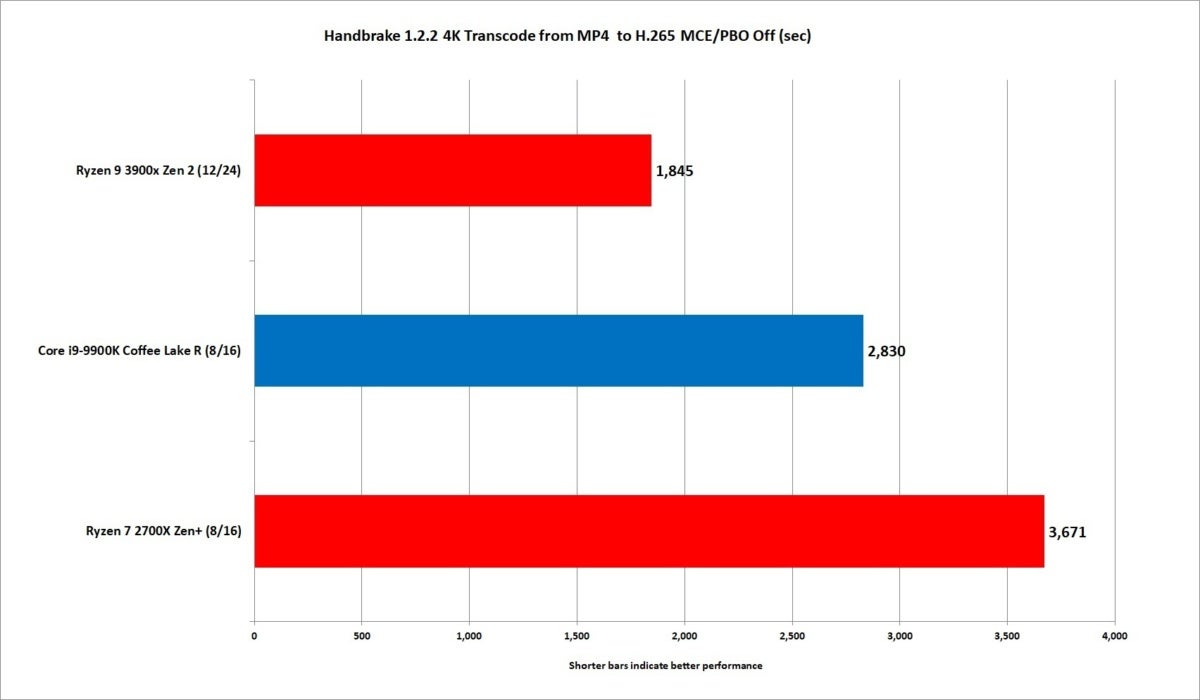 IDG
IDG The Ryzen 9 3900X easily wallops the Core i9 when doing a 4K cypher victimization the H.265 codec.
It's other big, big win for the Ryzen 9 3900X for CPU-based encoding. But we'd cost derelict if we didn't besides observe that the one ace the Core i9-9900K has up its sleeve is QuickSync encoding. Rather than using the all-purpose CPU processors to change over the TV, the Core i9 has a built-in GPU with fixed routine processors that cause solely one matter, merely screw stupidly latched.
Convert the television on the eight CPU cores of the Core i9, and you'Re looking a 47-minute wait. Commute it happening the 12-CPU cores of the Ryzen 9 and you're looking at near 30 minutes—fair enough for a short lunch. But use QuickSync's H.265 fixed function, and you'rhenium looking at 4 minutes. Just barely sufficiency time to grab a cup of joe.
Not wholly features or profiles in HandBrake purpose QuickSync, merely when it does—cursed.
In the end though, when you're doing a CPU-based encrypt, Ryzen 9 wins hands down.
Our side by side test is New to us but doesn't require the anguish of installing a riddled TV redaction suite to run. Cinegy free Cinescore was created to give the broadcoast industry a quick and easy fashio to assess CPU and GPU operation. It runs tests from SD, to HD, UHD and 8K crossways both CPU and GPU. Cinescore also uses codecs as varied as XDCAM, MPEG2, H.264, H.265, DVCPro100, AVC_Intra as well Cinegy's own "countertenor-carrying into action" Daniel2 codec.
Our machine configurations were the same for previous tests and all of the Cinescore results were obtained with Nvidia GeForce RTX 2080 Ti card game. We'rhenium only reporting the composite make for SD, HD, UHD and 8K runs. As you can, there's non a good deal of a storm and Ryzen 9 3900X again hands down outruns the Core i9 chip.
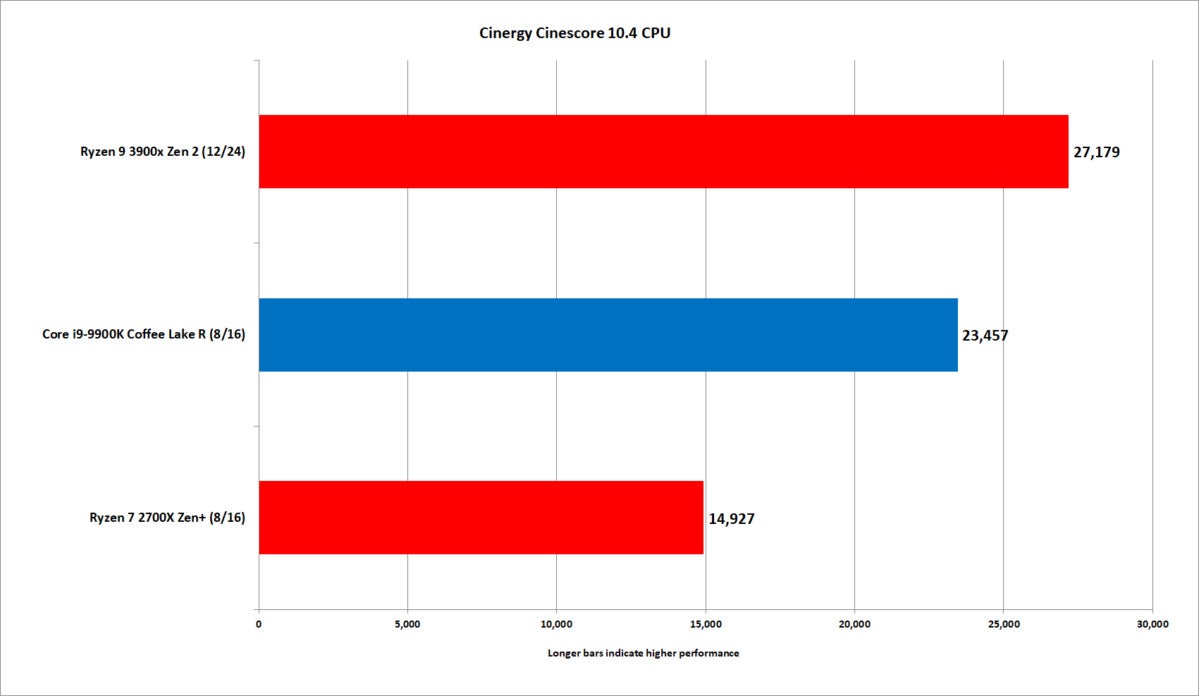 IDG
IDG Using Cinegy Cinescore 10.4, the Ryzen 9 continues to dominate the Core i9 check.
We'll remnant our encoding test with Adobe's popular Premiere CC 2019. For this run we use footage guessing by PCWorld's picture department for a story on HP's Chromebook 13. The video was shot at 4K resolution using a Sony Alpha A7 II, which was then edited for the video you behind view here. For this test, we use the latest version of Premier CC 2019 and export information technology using the Blu-ray preset using the Level bes Render quality flag. All three projects were read and holographic to the same Plextor M.2 SSD to remove storage as a variable in the examine.
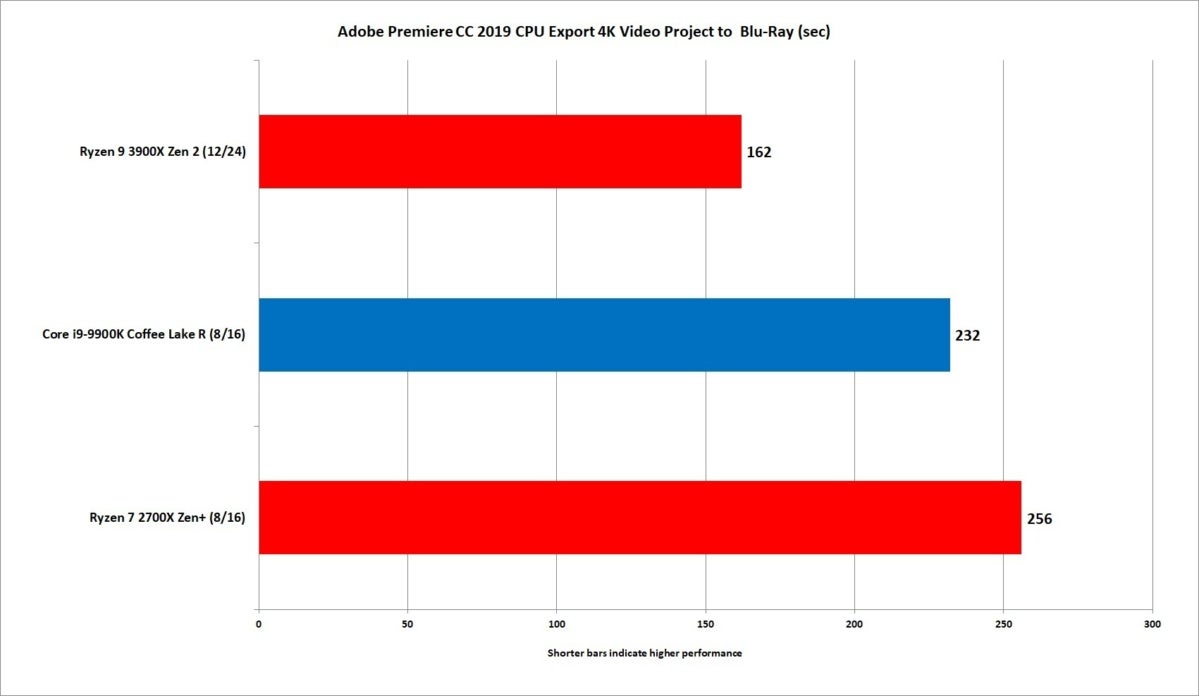 IDG
IDG The Ryzen 9 3900X's extra cores let it beat up on the Substance i9 in Premiere CC 2019.
We exported video using HEVC likewise. The Ryzen 9 3900X continues to blow past the Core i9, but the gap closes up a trifle. Motionless, a shorter bar means less time squandered no matter how you cut up it.
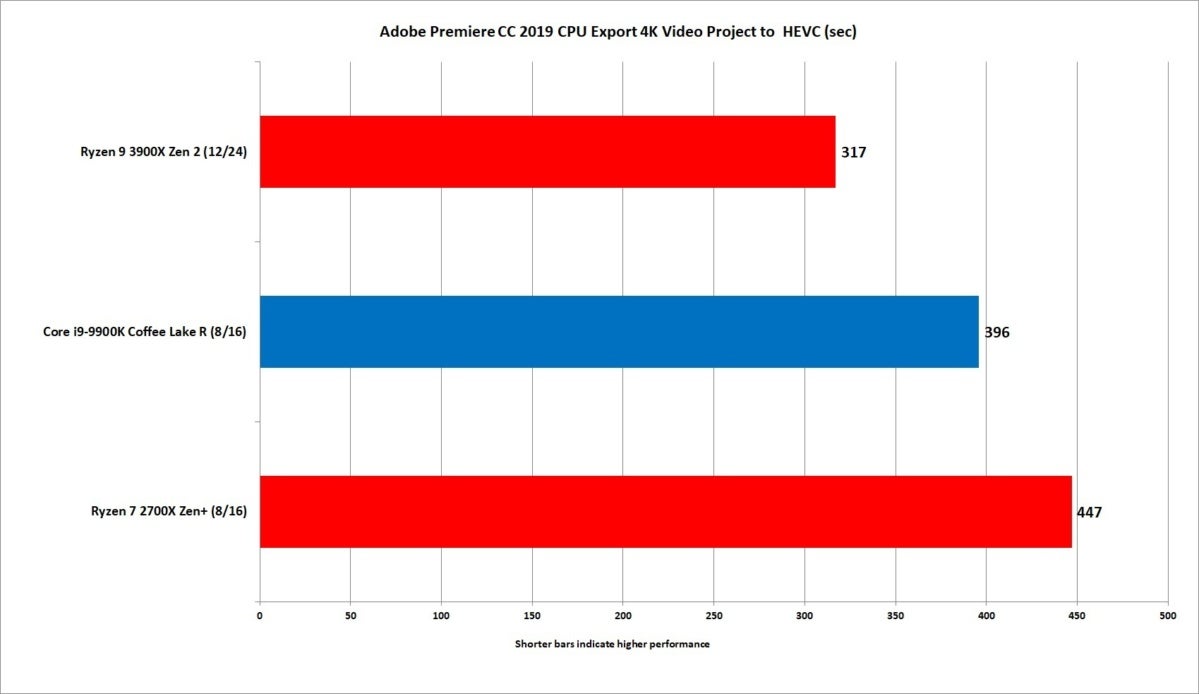 IDG
IDG We also exported our Premiere stick out using the Premiere's HEVC encoder, which is authorised from MainConcept.
Ryzen 3000 Photoshop Performance
We don't normally use Adobe brick's popular Photoshop as a carrying out test because, well, you don't normally net the same dividends you do with modelling operating theater video encoding. Information technology's an application that's mostly balanced on single-threaded performance.
With the increased IPC and slightly higher clocks of the Ryzen 9 3900X, we did want to experience if it could hang with the mighty Core i9's high clocks. For this screen, we used Puget System's free Photoshop benchmark hand and selected the Photoshop Spread handwriting run. The Ryzen 9 3900X's score of 992 is very respectable and about 6 percent quicker than the Core i9-9900K's overall account of 932.
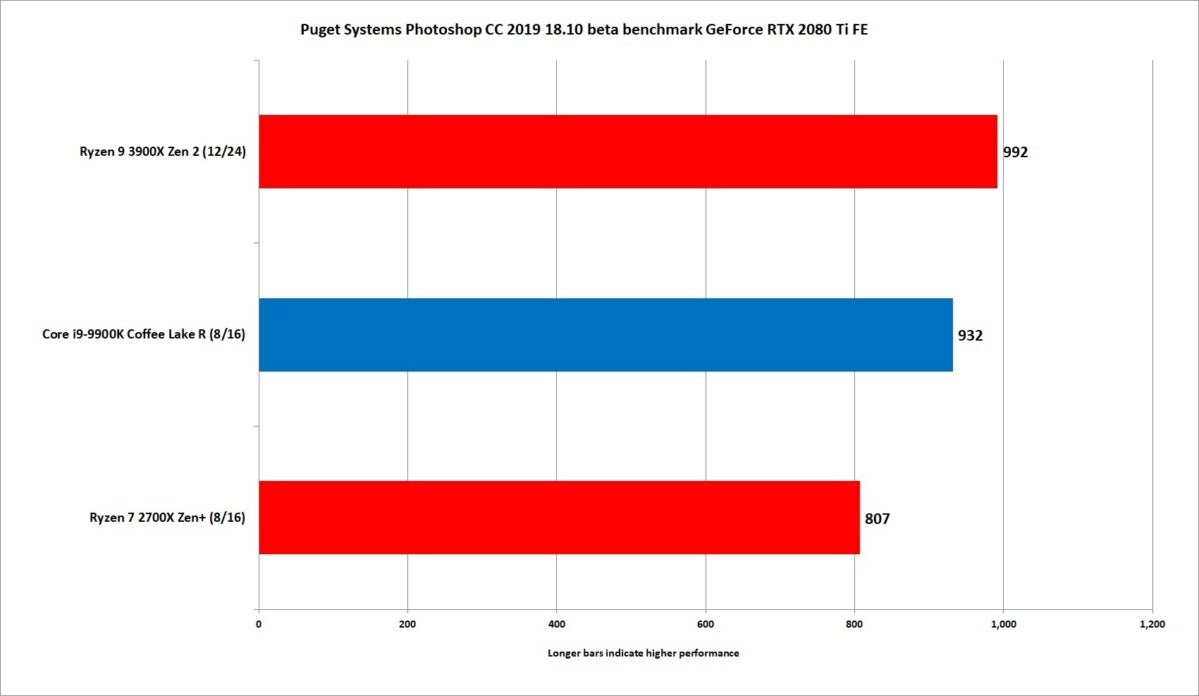 IDG
IDG The performance gap is slimmer, but the Ryzen 9 3900X still wins.
Ryzen 3000 Compression tests
Moving on to compression, we'll beef it off with RARlab's WinRAR 5.71. The program features a built-in benchmark, which we first run in single-threaded mode. The results render a big boost for the spick-and-span Ryzen 3000 chips over the Ryzen 2000 chips, every bit the new 4.6GHz rise Ryzen 9 3900X draws fairly more or less the 5GHz Burden i9-9900K.
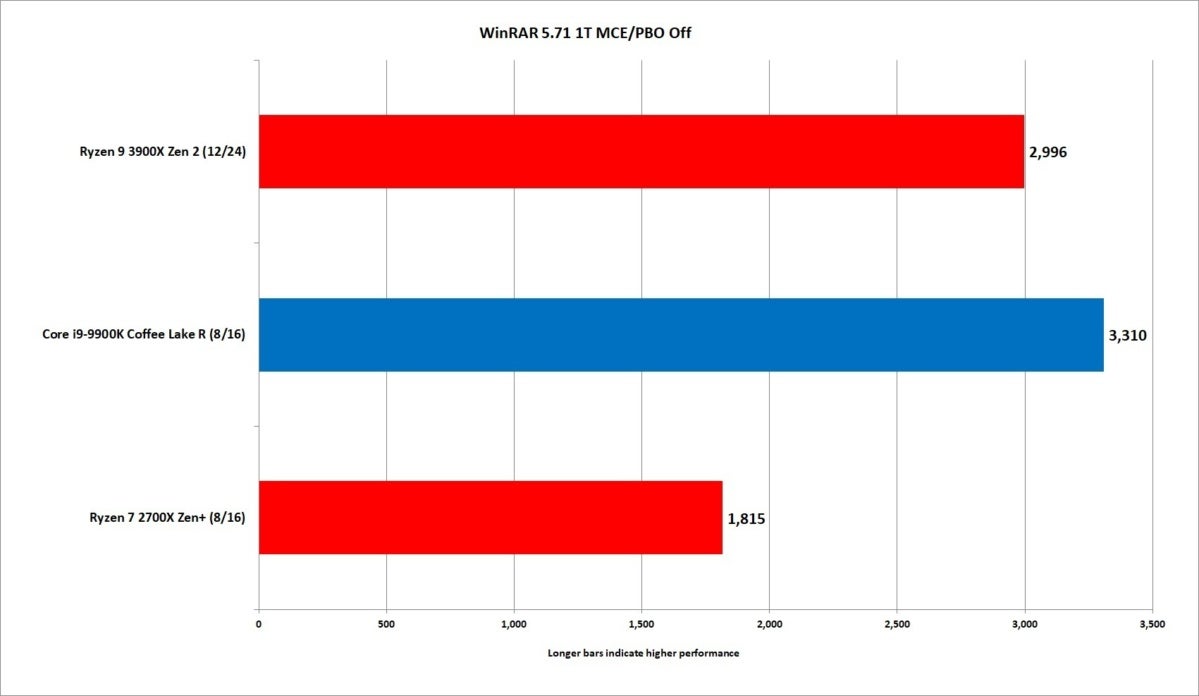 IDG
IDG The Ryzen 9 3900X actually offers up a same the right way uplift finished the late Ryzen 7 2700X.
Things go sideways when we shift to multi-threaded functioning. While the Ryzen 9 3900X actually turns in a decent result, information technology falls slightly behind the Core i9-9900K despite having four more cores.
We'll note that WinRAR typically hasn't likable Ryzen-based CPUs (nor Intel's Skylake X chips either). This result is a beautiful properly uptick for the Ryzen 9 3900X overall, just non the victory we expected after seeing how well the CPU performed elsewhere.
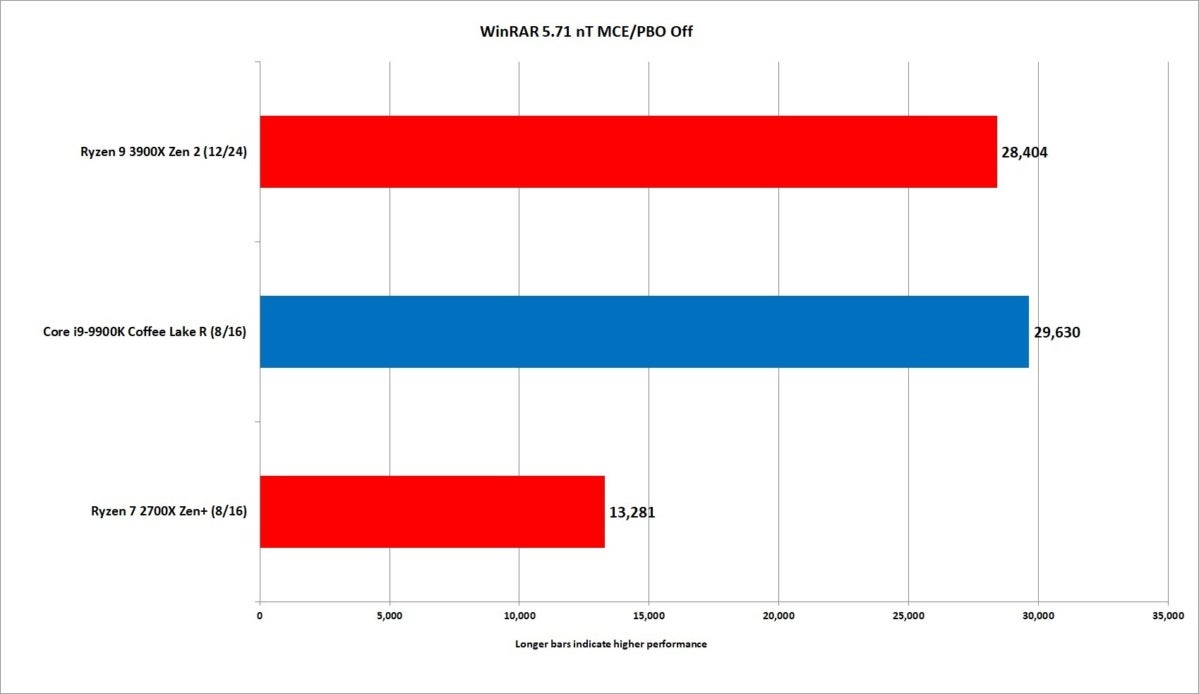 IDG
IDG This WinRAR result can be seen as upright or bad in more or less slipway. WinRAR has traditionally favored Intel CPUs, every bit we can see from the dismal carrying out of the Ryzen 7 2700X. The fact that the Ryzen 9 3900X is just about tied with the Pith i9 sack glucinium seen as an improvement.
The well behaved news show for Ryzen 9 3900X is its operation in the far more popular 7Zip is pretty damn good.
The run reports compression functioning and decompression performance. The app's creator has said compaction speed is mostly tilted to memory latency Eastern Samoa comfortably as data cache/size and speed public presentation. How a CPU can deal with out-of-Holy Order slaying besides helps.
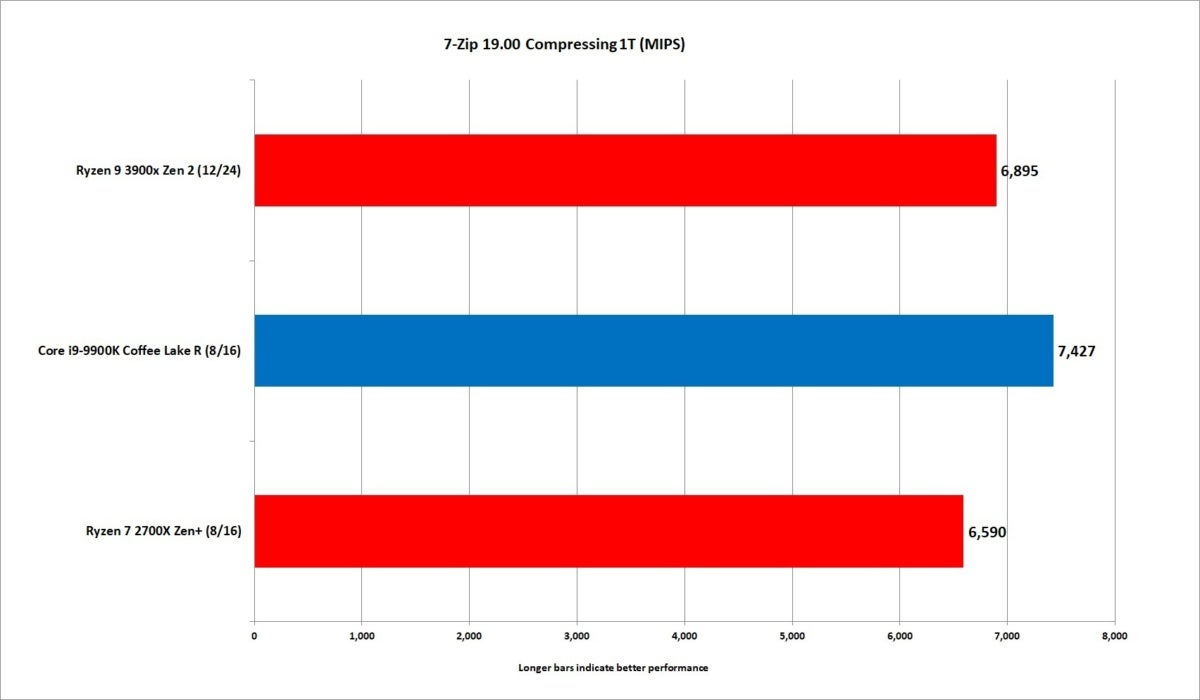 IDG
IDG The bingle-threaded performance in 7Zip slightly favors the Core i9 chip.
Decompression execution is largely reliant along integer performance and how well the CPU handles branch mispredictions.
We run 7Zip 19.00 exploitation the default on dictionary size of 32MB. We too pass around the amount of threads equal to the Processor's available duds, as well arsenic testing individualist-weave.
In single-rib performance, the 5GHz Core i9, with its roughly 8-percent time reward finished the 4.6GHz Ryzen 9, yields about a 7.5-percent operation reward in the compression component. In multi-threaded execution, we see the Ryzen 9 gain a 36-percent advantage all over the Heart i9.
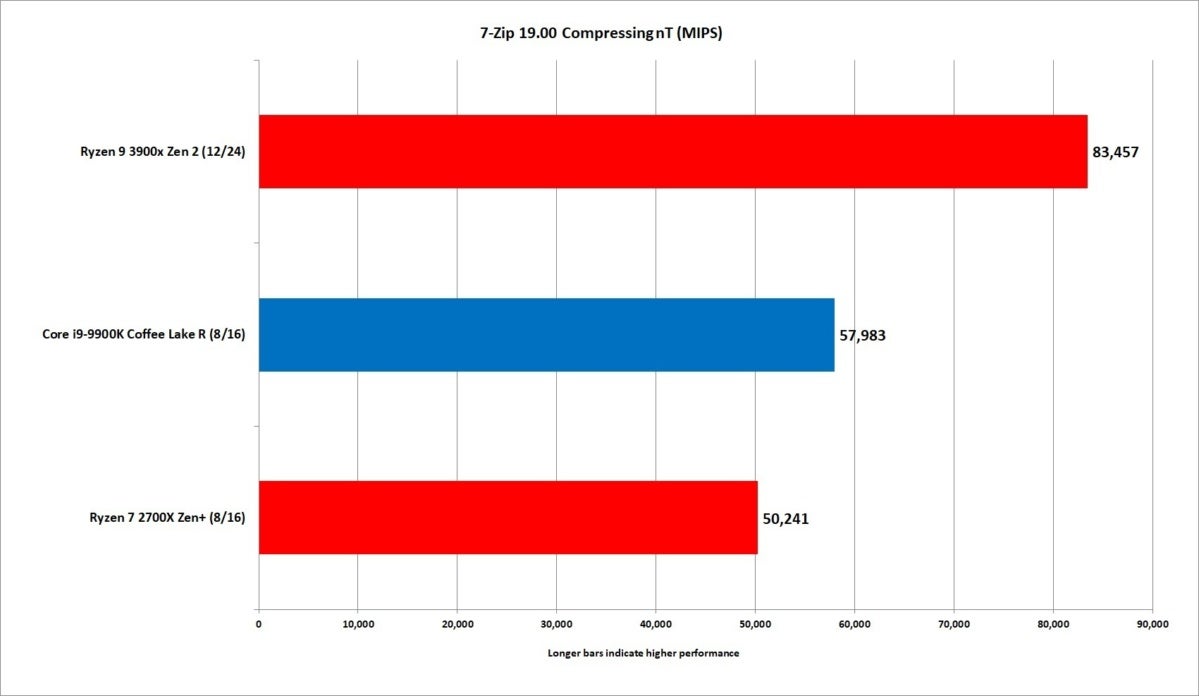 IDG
IDG Multi-threaded performance sees the Ryzen 9 dominate easily.
Moving over to the decompression test, the gap betwixt the Core i9 and Ryzen 9 closes to 5 percentage in favor of the Intel CPU. When you factor all told of the CPU cores obtainable, the Ryzen 9 sprints past to the Core i9 by a whopping 46 percentage.
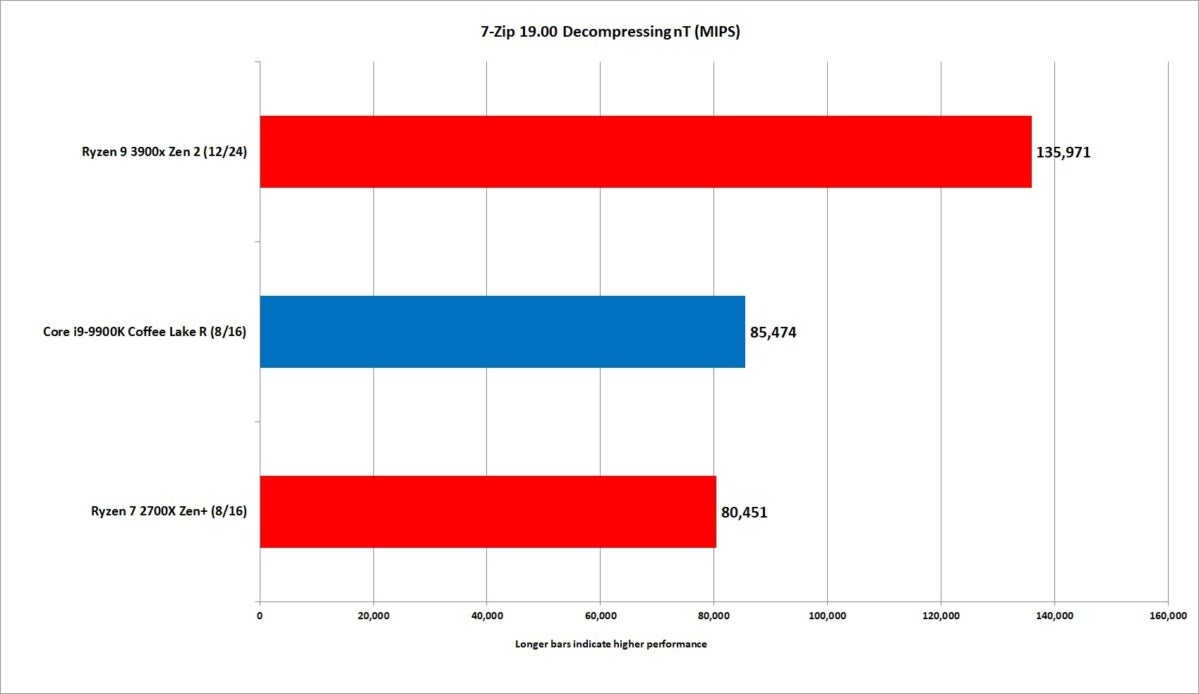 IDG
IDG Decompressing is traditionally greatly limited away integer execution you said it right a CPU lavatory handle branch misprediction.
While the Core i9 has a single-fingerbreadth advantage in single-rib tasks, we have to say the Ryzen 9 is so close it doesn't matter. When you yawning it upwardly to all cores—it's an big licking.
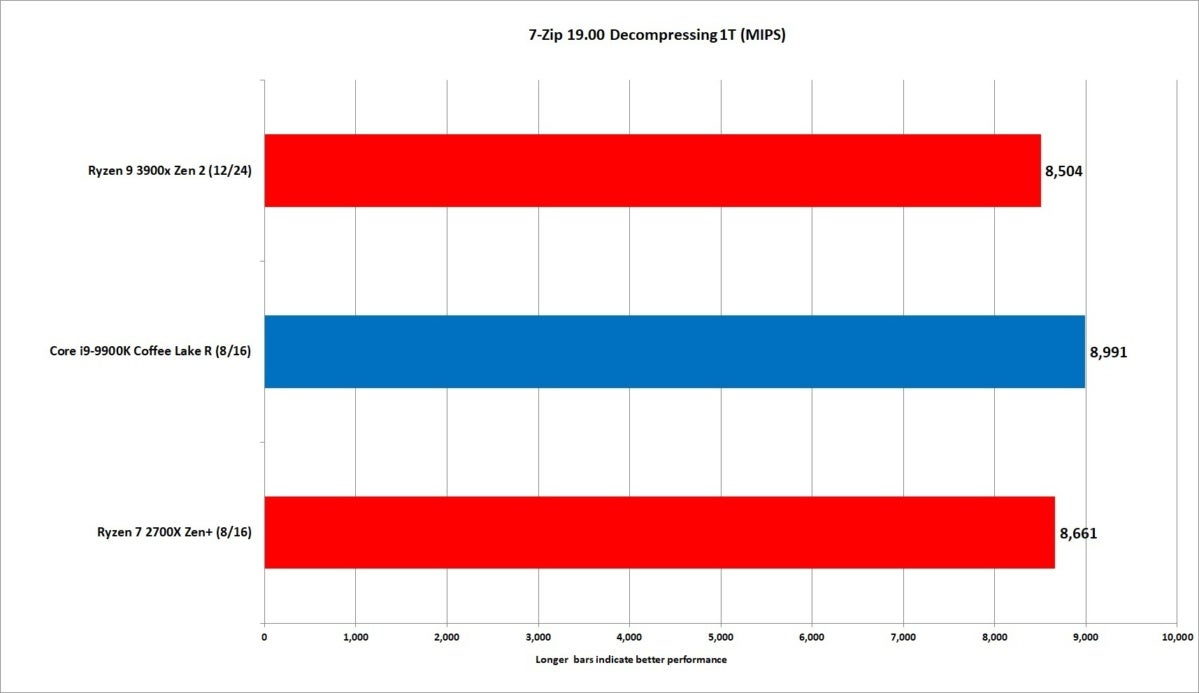 IDG
IDG In whole number performance, the results indicate single-threaded performance is nearly a tie between all three, with the Core i9 squeaking verboten ahead.
Keep reading for game carrying into action testing
Ryzen 9 3900X Gambling Performance
It's beautiful overmuch been all sun and roses for the Ryzen 9 3900X so far. The final motion is its gaming public presentation. Ever since the original Ryzen 7 1800X launch, gambling, specially at lower resolutions where the gamey ISN't bottlenecked by the GPU, has been nothing but controversy. It's also been the one shining sphere for Intel.
As we same earlier, for our tests, we used GeForce GTX 1080 FE card game and also RTX 2080 Si cards. We did our primary examination at 1920×1080 resolving power and also reliable at 2560×1440. To save you space, we pretty much omitted the results at 2560×1440 resolution because, well, you get into't want to look at a bunch of results where they'rhenium all nigh the same. Even in tests where the Ryzen 7 2700X might free fall behind, information technology's not really that big of a deal in GPU-limited gaming.
First up is Shadows of the Tomb Raider, which we keep going the GeForce GTX 1080 FE card victimisation the Highest Quality settting. As you can see, it's a tie! Succeed right? Considerably, not really. The real issue is using the Highest Quality mount is enough to make the now old GeForce GTX 1080 FE look honorable slow. IT's the bottleneck with these CPUs.
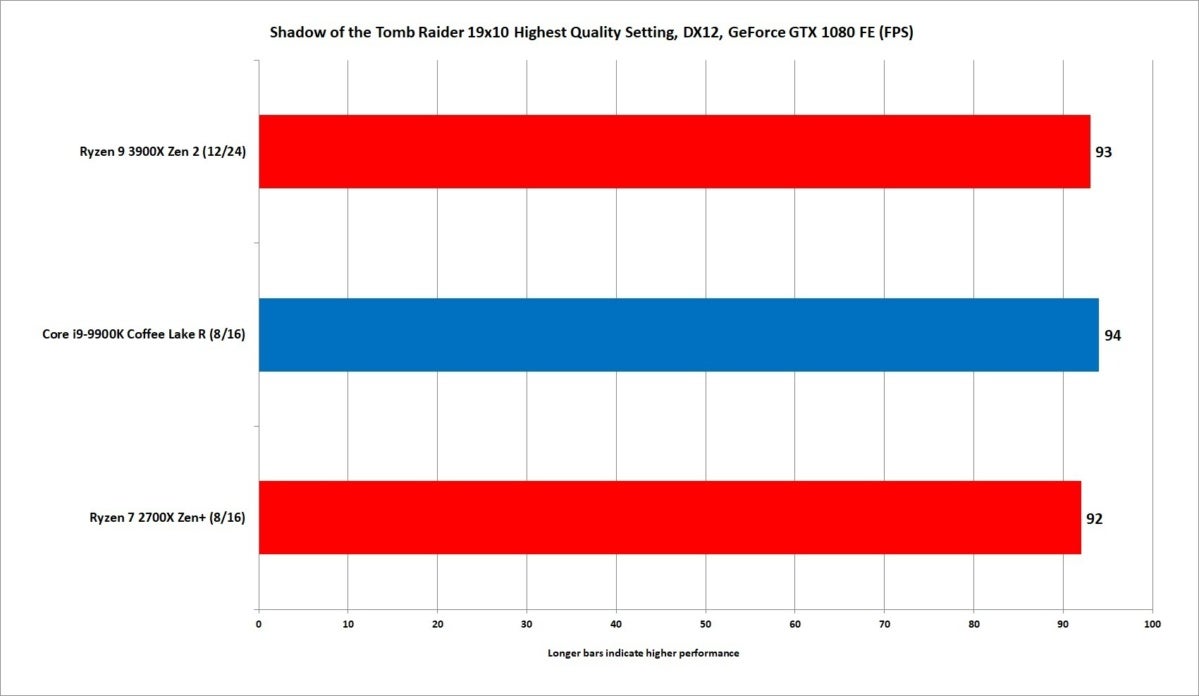 IDG
IDG As you can see, Shadows of the Tomb Looter, even at 1920×1080 resolution, is bottlenecked by the GPU.
You can see why the minute we swap in the mean, slender GeForce RTX 2080 Ti FE: The Ryzen 7 2700X immediately falls to a distant third base place. But how does that Ryzen 9 3900X do? We'd have to say pretty good,as it's about 7 percent slower than the Nucleus i9-9900K (that has a 8-percent high clock speed.) It's certainly better than the Ryzen 7 2700X, which exhibits the same problems with 1080p gaming that the original Ryzen 7 1800X suffered arsenic well.
 IDG
IDG Playing modern games with the new Ryzen 9 or Inwardness i9 needs a fast GPU too.
Moving on to the slightly experient Upgrade of the Tomb Raider, we over again see just how a "retard" tease alike the cold GeForce GTX 1080 FE is the bottleneck in RoTR. It's basically a three-way tie along the 1080, and you'd believable see that happening any card short of an RTX 2080 and up.
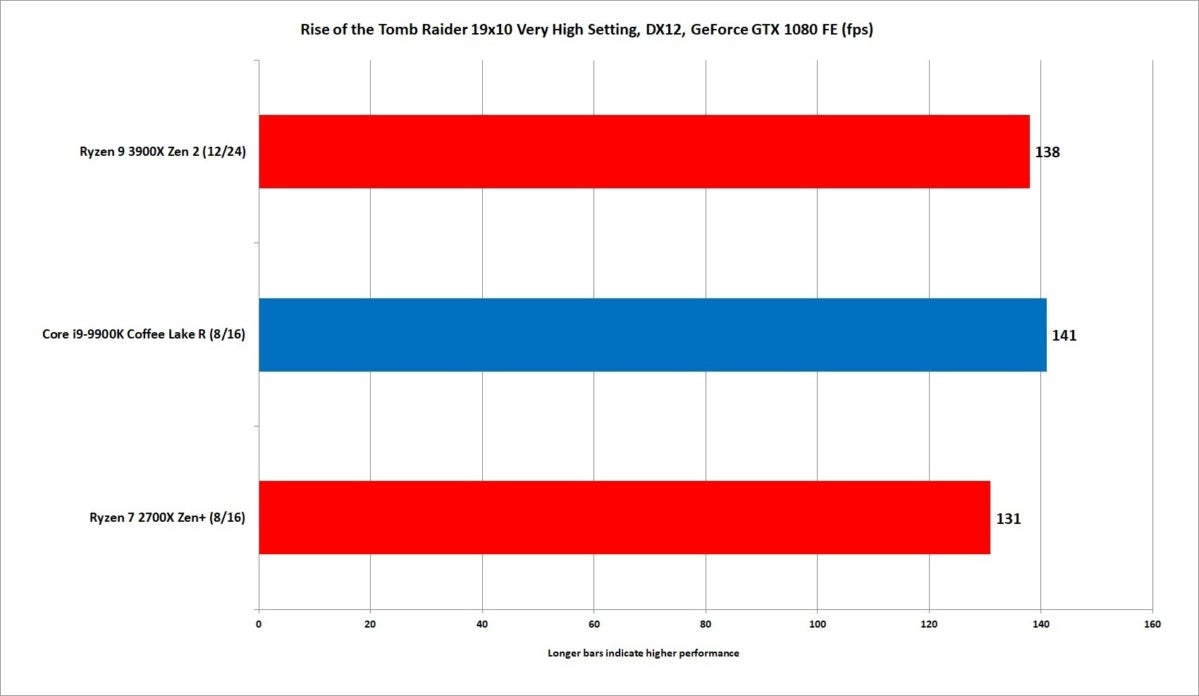 IDG
IDG The GeForce GTX 1080 FE is the constriction hither happening gaming.
Fortunately, Nvidia makes that handy $1,200 GeForce RTX 2080 Ti card, which smooth slightly favors the Core i9 but only aside astir 2 per centum. The Ryzen 7 2700X seat't say the same as it trails by the familiar amount we're victimised to with sr. Ryzen CPUs against Core.
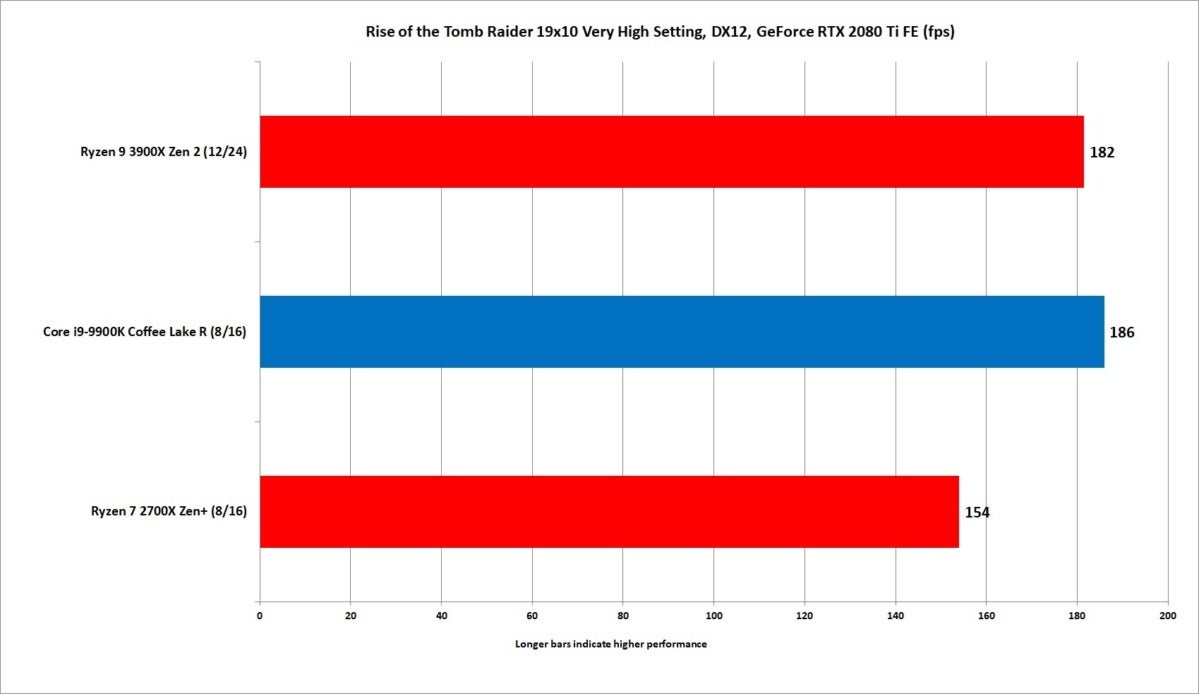 IDG
IDG The Ryzen 9 3900X doesn't beat the Heart and soul i9, but IT's pretty finale.
If you're hither to meet the Ryzen 9 3900X leave the Heart and soul i9-9900K eating its dust in gaming benchmarks, prepare to cost disappointed. For the just about part, altogether of the games we proven, the Ryzen 9 3900X generally trailed by single-digit ranges of 1 percent to 7 percent in most games using that wicked GeForce RTX 2080 Ti FE.
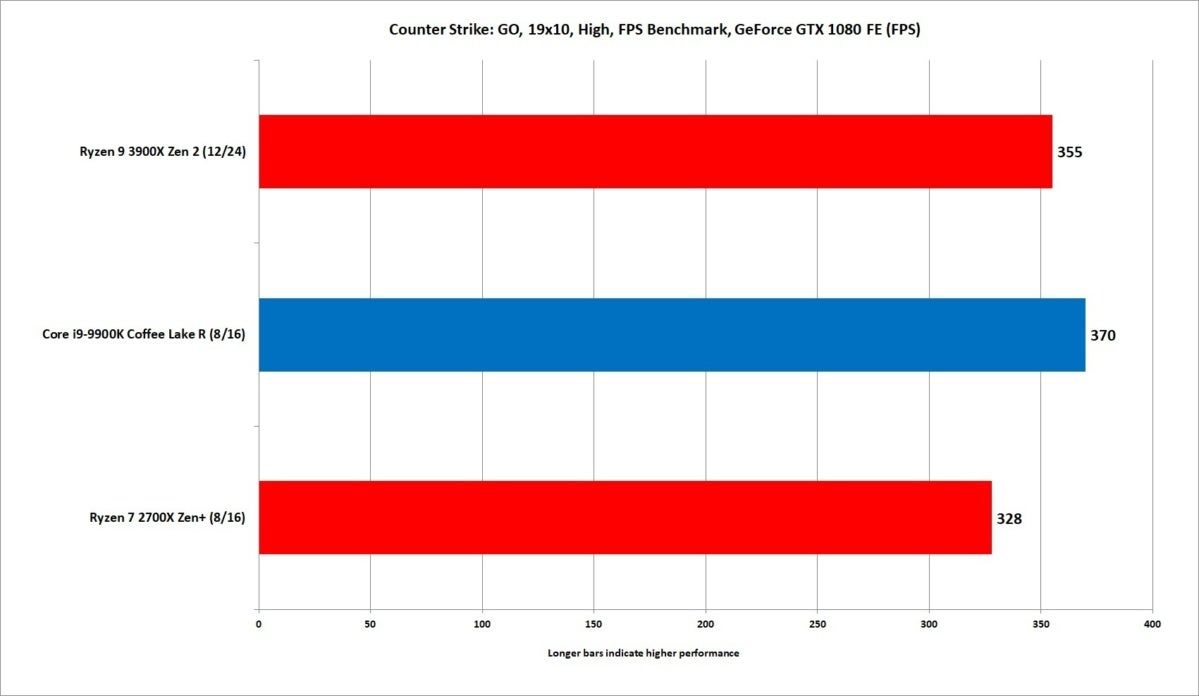 IDG
IDG The ancient Cesium:Go is a bet on we only needed to break unconscious the GTX 1080 FE for. It's not suchlike you need more than 300 Federal Protective Service.
Ryzen fans shouldn't bring up that as a loser. In many shipway, we see it as a win for Team up Bloody. Remember: The two previous generations of Ryzens have trailed Core i7 and Core i9 away two-base hit digits in the vast majority of games at 1080p settlement. To run into the Ryzen 9 just about striking aloofness in just about every plot we ran is a major upgrade. That besides means you wish occasionally hit games where the Ryzen 9 3900X flops against Core i9.
In Far Cry 5, we actually power saw a fairly big gap of about 15 percent between the Ryzen 9 and Core i9. Of the games we tested, Far Call 5 coughed up the largest gap but lest you think the situation isn't improved o'er 2nd gen Ryzen much that's not true. As you butt fancy, the Ryzen 7 2700X sits tied further rear than the Ryzen 9 2900X.
(In our original review, we were unable to run Far Cry 5 the Ryzen 7 2700X due to game activating limitations with our legally licensed copy. We've since updated results with Far Cry 5 and Deus Demode: Mankind Divided.
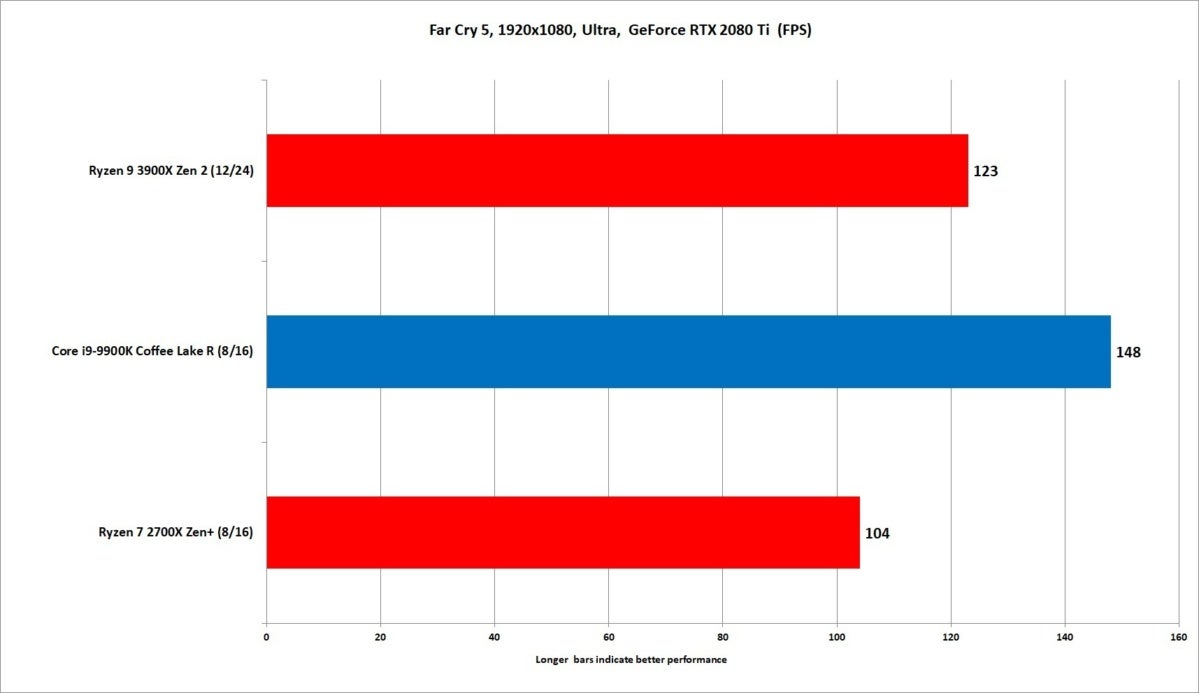 IDG
IDG Far Cry 5 is one of the titles that Core i9 heavily leads the right smart connected.
That graphic preceding might give you a heartache, simply most of the games looked like Deus Passee: Machina, which gave the Core i9 about a 7-percent lead o'er the Ryzen 9. (Yes, the copy protective cover for Deus Ex gave up the ghost during our examination runs too, so the Ryzen 7 2700X was not tested with the RTX card.)
We ran the popular game Rainbow Sise Siege with similar results. Sure, Ryzen 9 is in minute put, but non past some. Compare its results to the Ryzen 7 2700X.
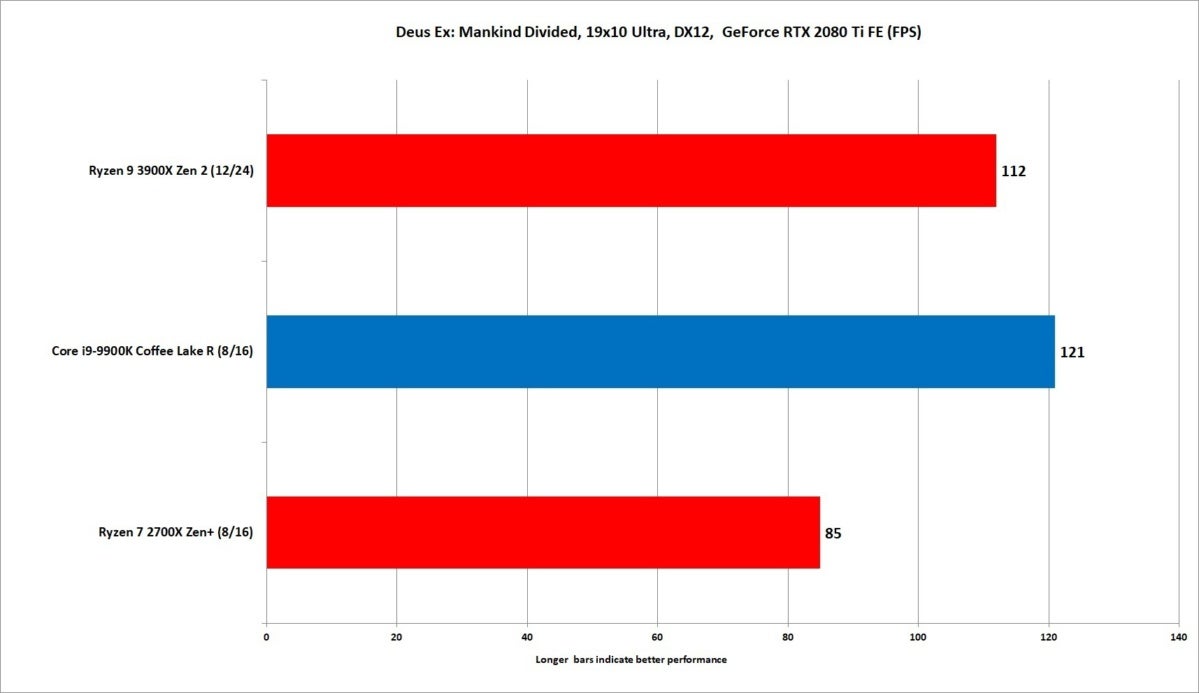 IDG
IDG Yes, Ryzen gaming has improved. One deal the performance of Deux Exwife: Mankind Divided betwixt the two Ryzen chips.
If we had to call a superior based solely on gaming, we'd give it to the Core i9. Only the slim victory makes it just a victory at completely, because even the Core i9's wins are by such small margins—certainly far smaller than against any older Zen or Superman+ CPU. And we have to move all the way to a $1,200 graphics card to see the separation. We really think anything below an RTX 2080 will belik make information technology closely impossible to recite the difference between the 2 CPUs at 1920×1080.
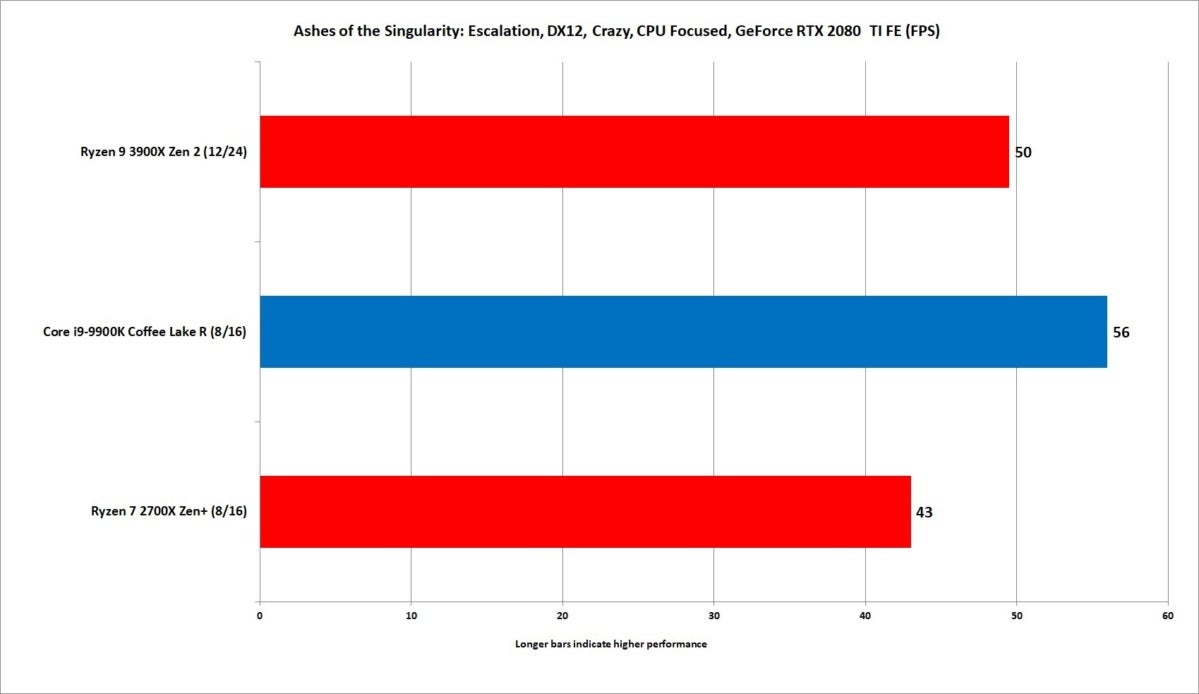 IDG
IDG The Central processor Focused Mental test in Ashes is indeed a CPU examine, because we scantily saw skeletal frame rates budge going from a GeForce GTX 1080 to GeForce RTX 2080 Ti.
Conclusion
To close off our review, we like to runnel Cinebench using from 1 thread to 24 threads. Cinebench R20 is a 3D modeling bench mark that doesn't predict gaming performance or other application performance, but a lot of games and applications just can't take advantage of wholly the threads in new CPUs. That's why Cinebench R20 has value in demonstrating performance when the CPU is loaded up from 1 thread and up.
On the chart beneath, AMD typically dominates the right side of the chart, where information technology almost always has an advantage in the number of cores over Intel chips.
Intel, on the other turn over, typically loses along the right side but wins on the left side, because it usually has a clock hotfoot and IPC advantage over AMD chips. That's basically given Intel's Core chips their only edge, because the large legal age of applications and games rely happening performance along the left side of our graph. Well, if you deal our chart today 'tween the Ryzen 9 3900X and the Core i9-9900K, that senior rationality is essentially gone now.
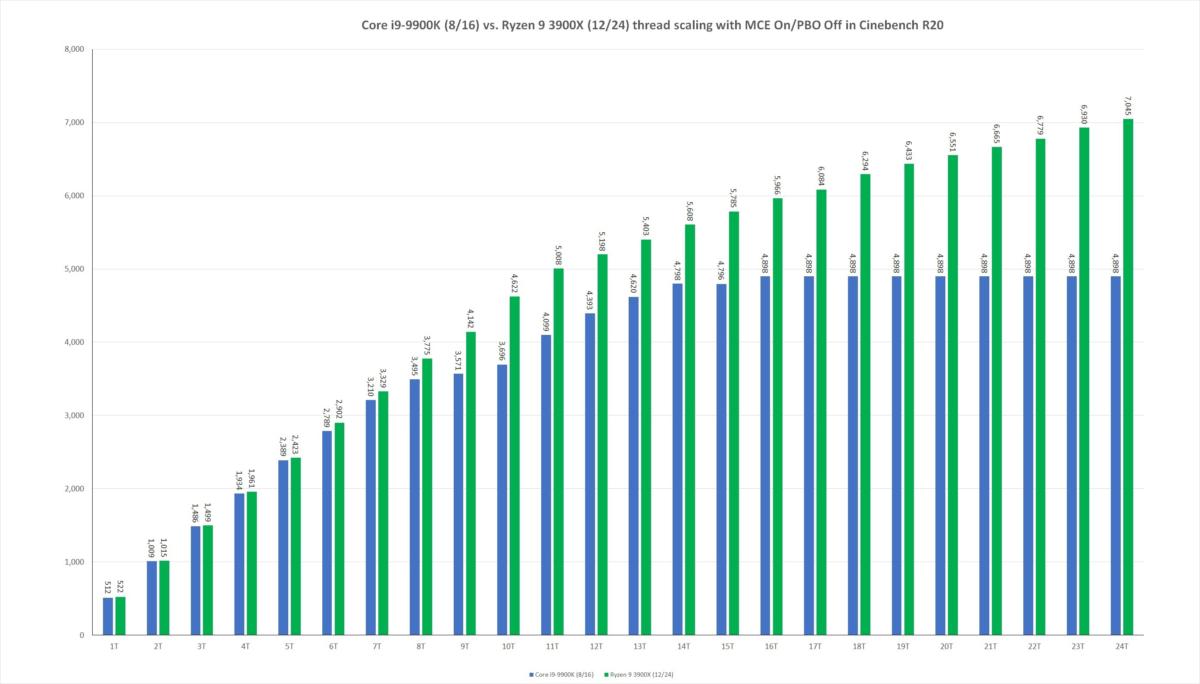 IDG
IDG When you run Cinebench R20 using 1 thread to 24 threads, we can project the Ryzen 9 3900X's real strength as it gives up no quarter to the powerful Core i9.
For another view of the same information, we've whipped up a chart that shows the performance advantage as a percentage. As you can project, the simple math of 12 cores > 8 cores wins crowing clip.
The whip news for Intel's Core i9 is formerly over again connected the left side of the chart. In that location's nothing left here. The 2 are are a dead tie heavenward to sextuplet threads, where the Ryzen 9 takes over.
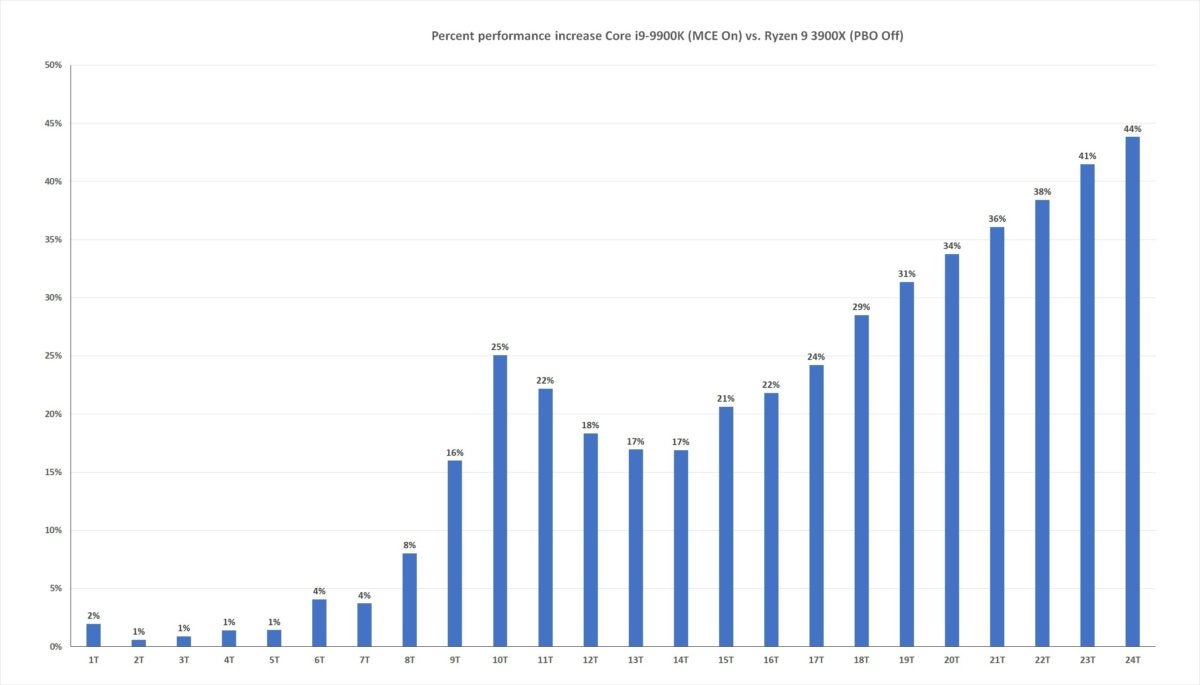 IDG
IDG The Ryzen 9 is basically dead even with the Core i9 when loaded equal to 8 threads. After that, the 12-core chip pulls away at warp bucket along from the 8-core chip.
Along those low-thread-count loads, the Ryzen 9 3900X is every bit atomic number 3 fast as the Core i9-9900K. This basically way there are very a couple of reasons left to bribe a Core i9 today. The reasons left are real, but for probably 9 out of 10 consumers looking a high-stepping-end CPU, they'll want to bargain the Ryzen 9 3900X.
Note: When you purchase something after clicking golf links in our articles, we Crataegus laevigata earn a small commission. Read our affiliate link policy for more details.
One of founding fathers of expressed technical school reporting, Gordon has been covering PCs and components since 1998.
Source: https://www.pcworld.com/article/397690/ryzen-3000-review-amds-12-core-ryzen-9-3900x.html
Posted by: johnsonnoteduckers.blogspot.com


0 Response to "Ryzen 3000 Review: AMD’s 12-core Ryzen 9 3900X conquers its past - johnsonnoteduckers"
Post a Comment